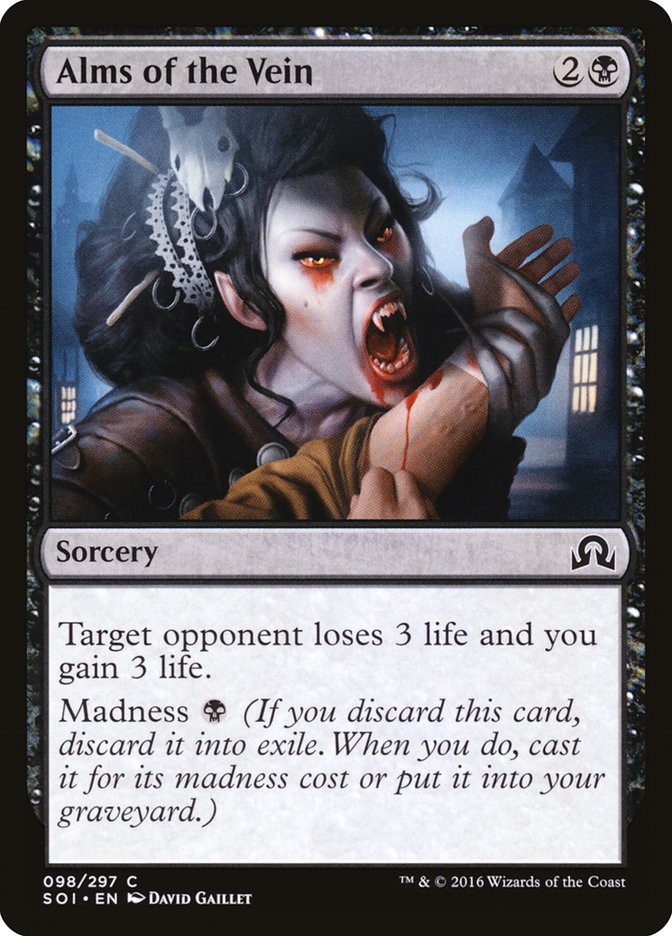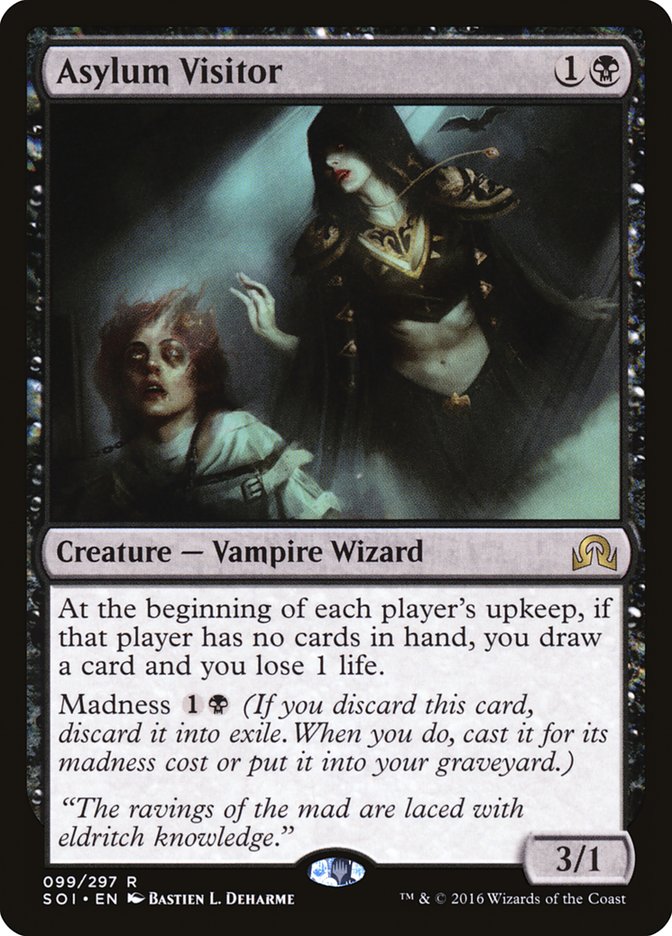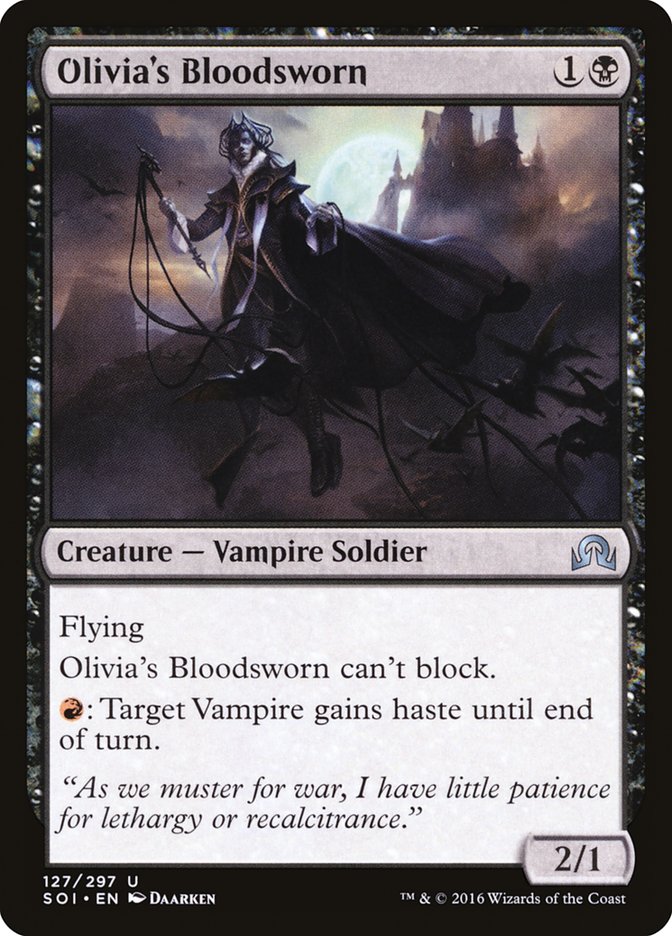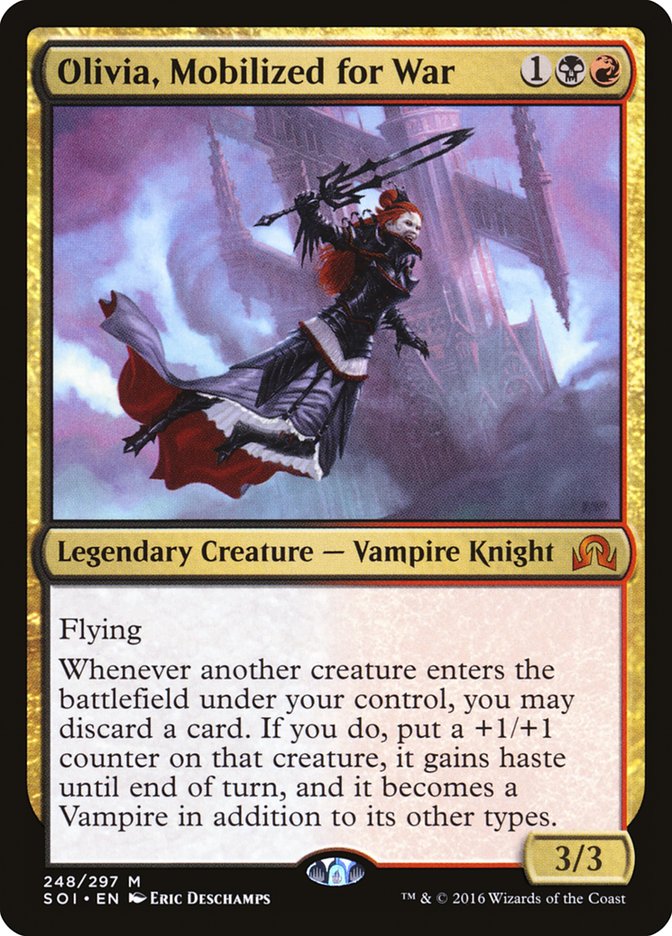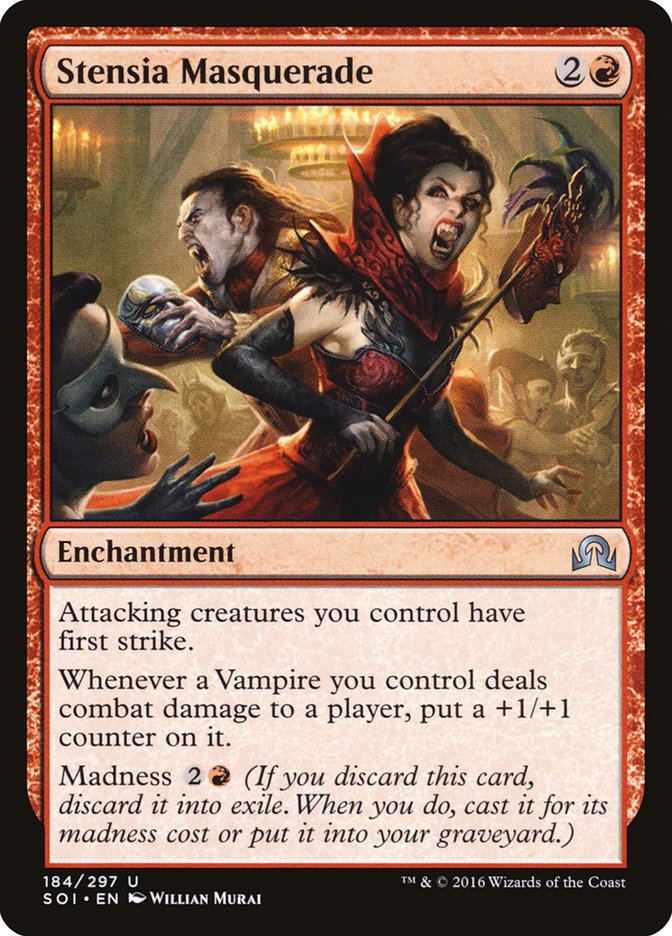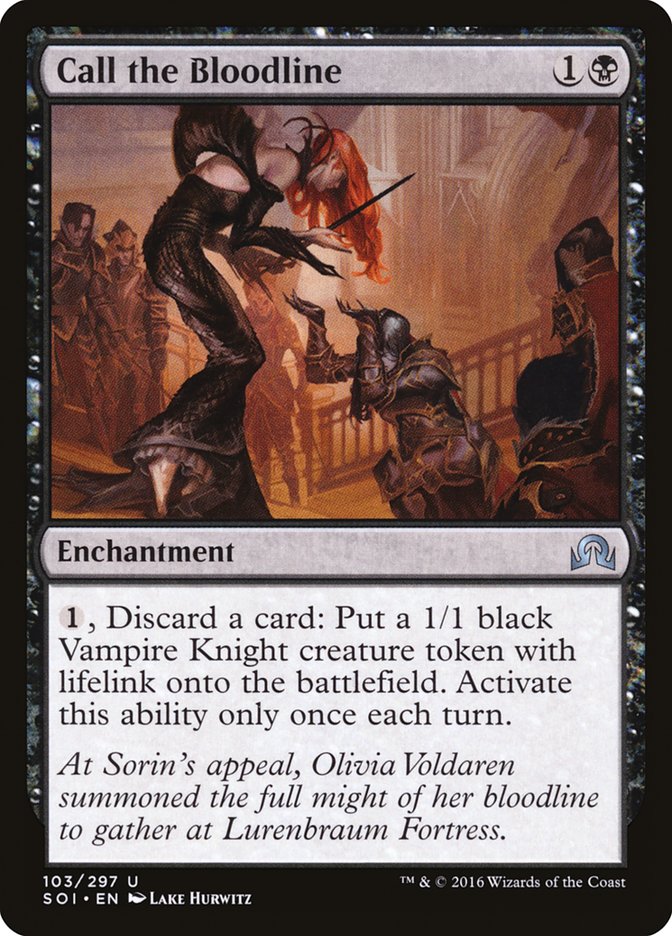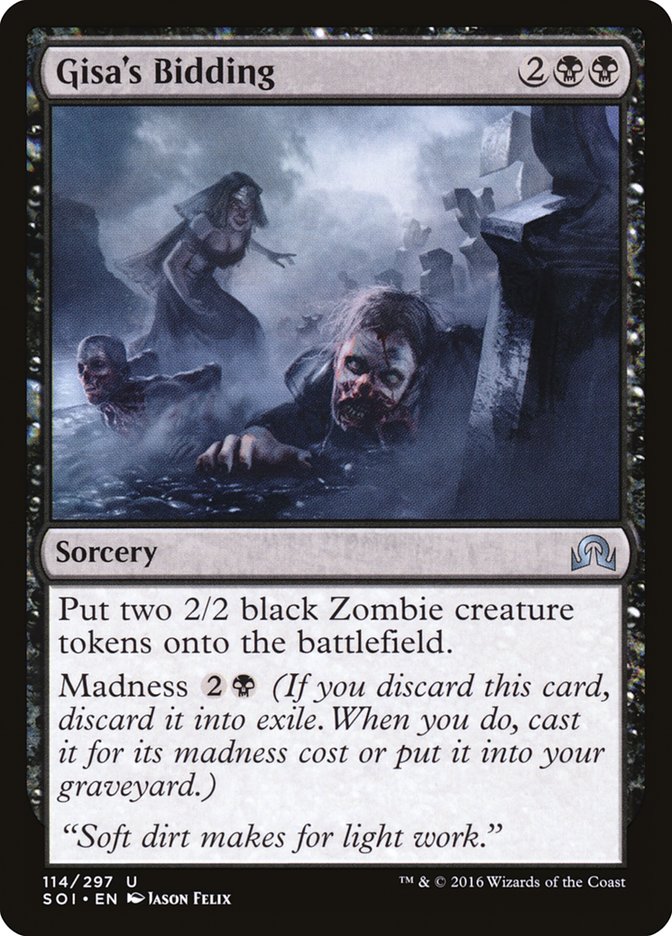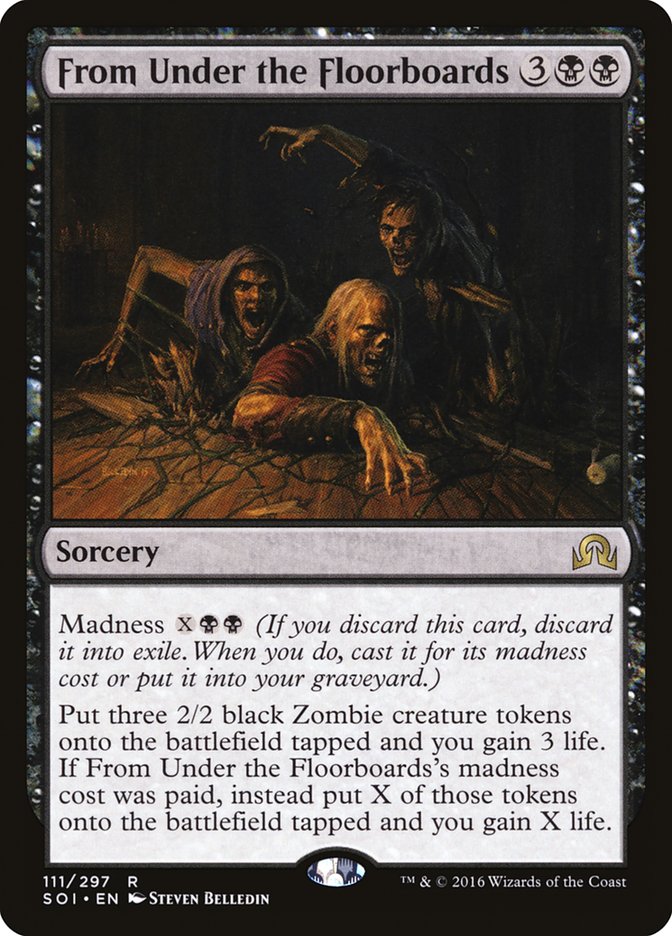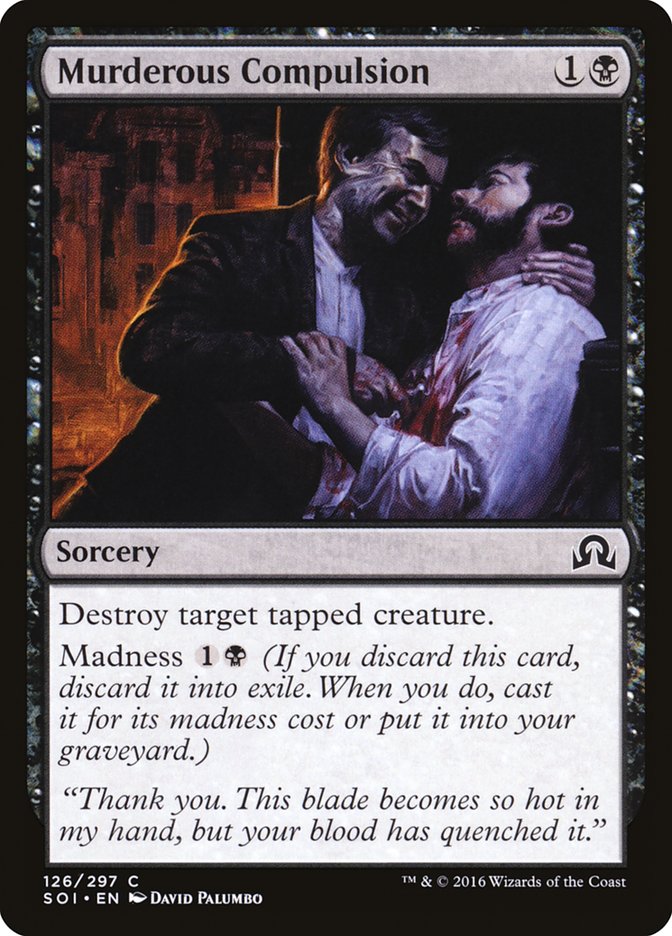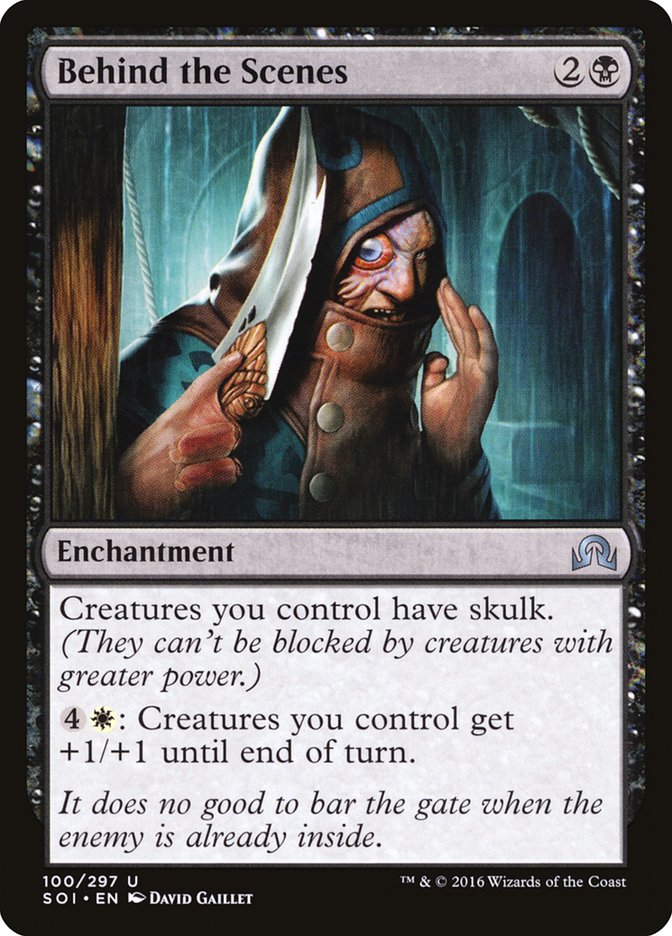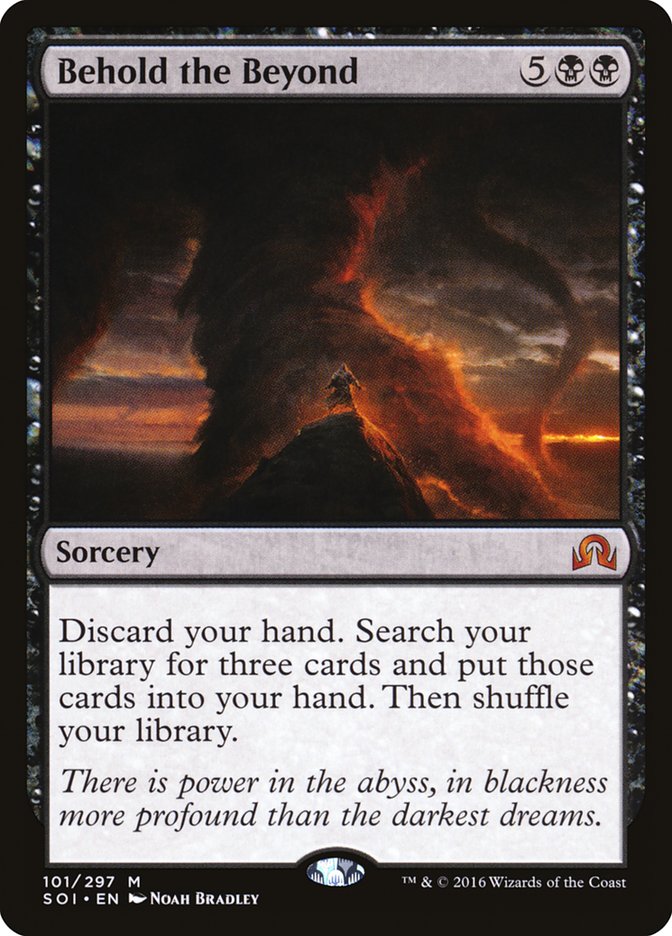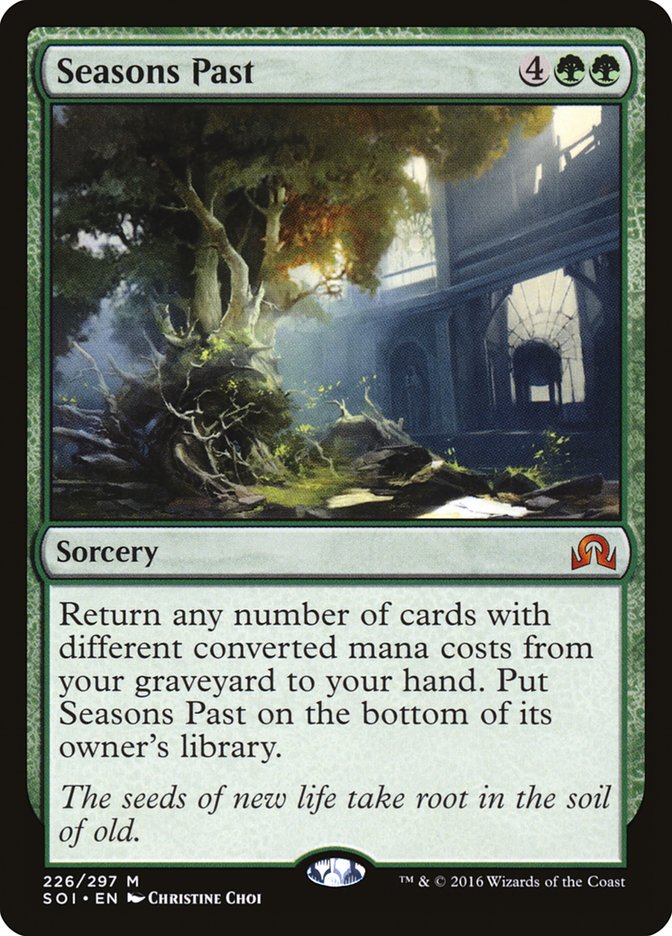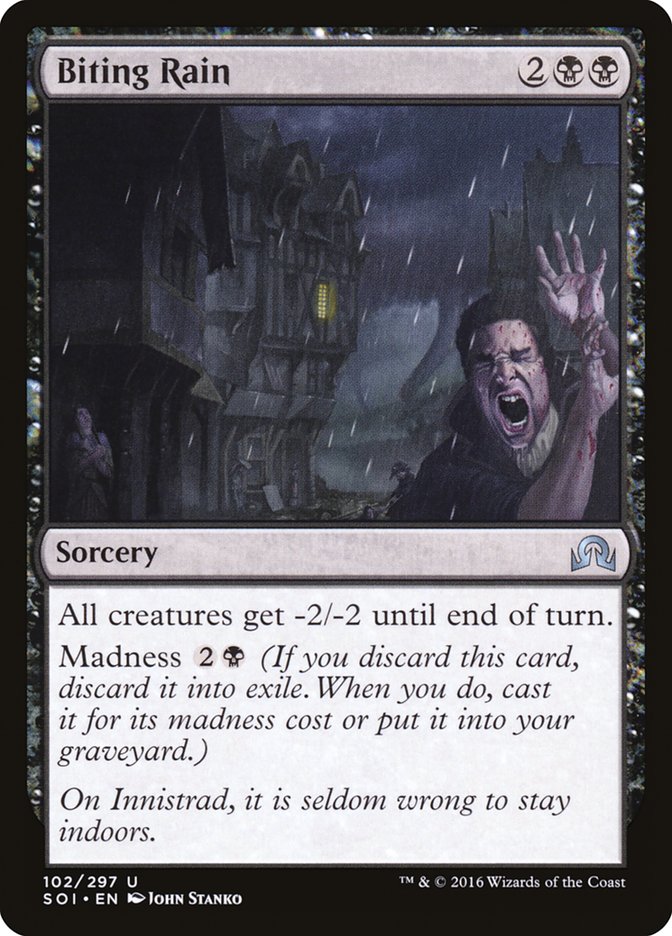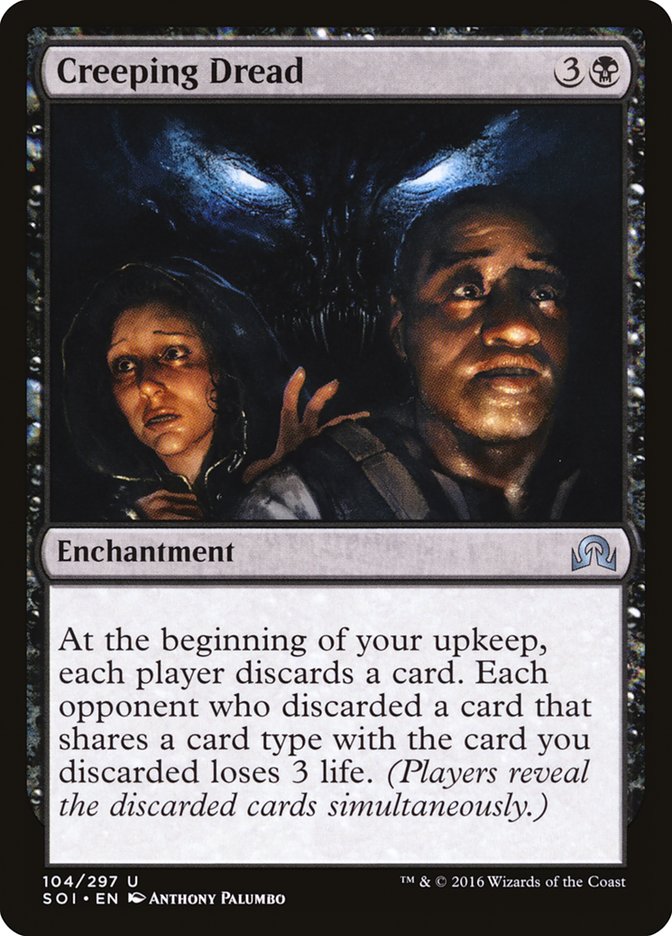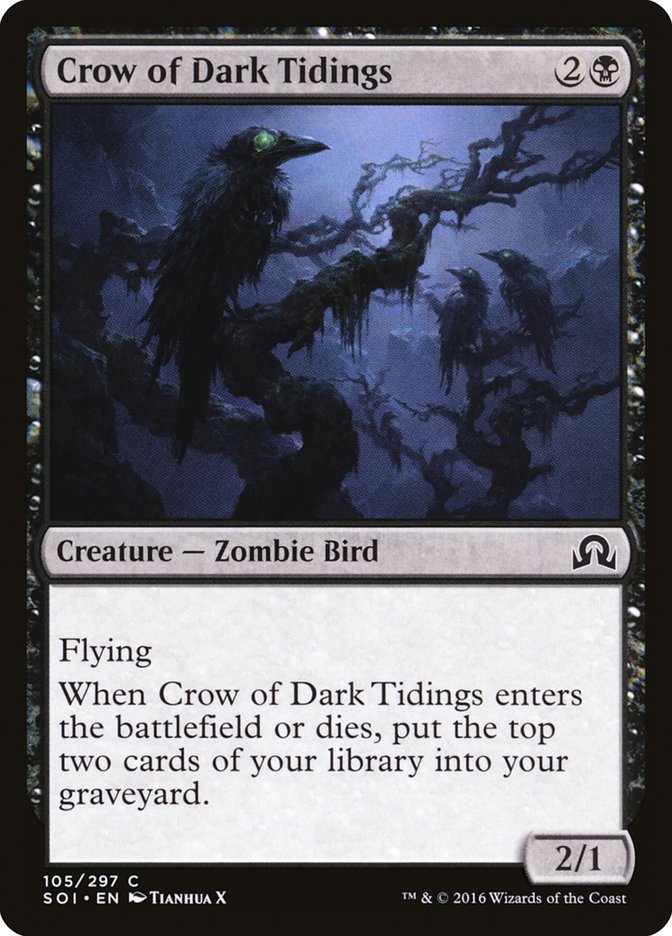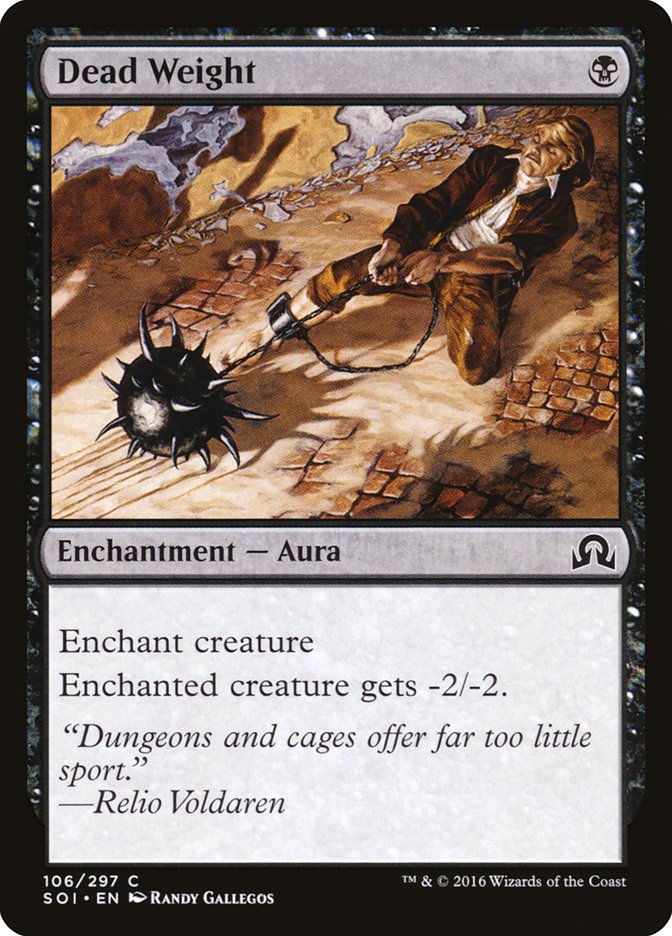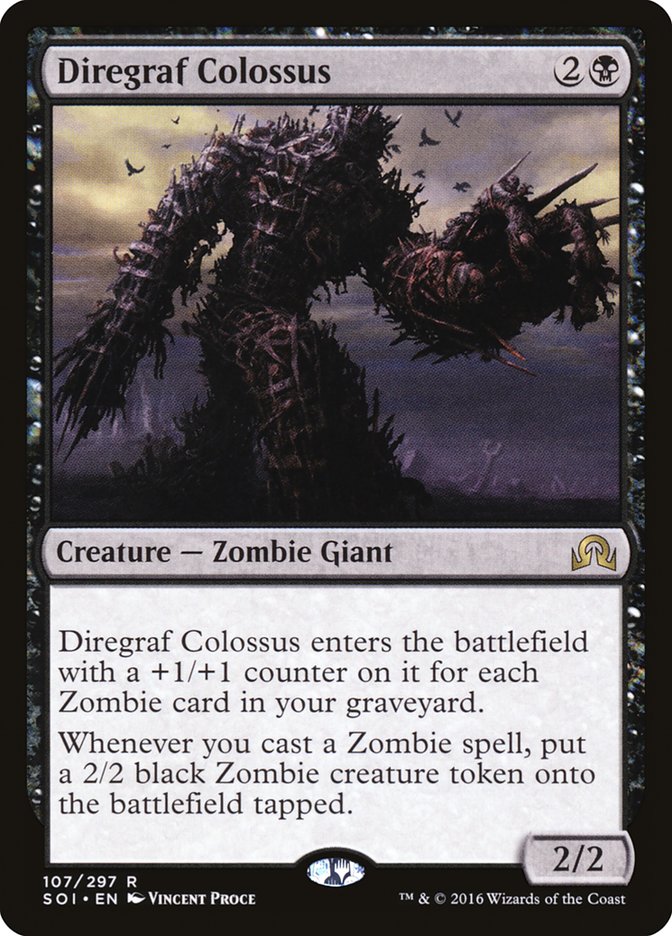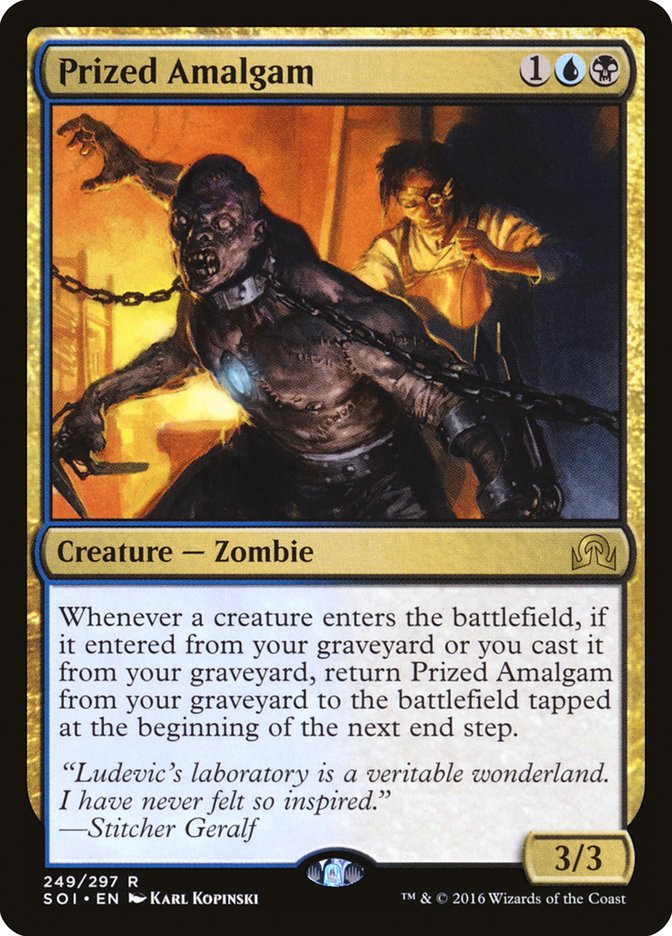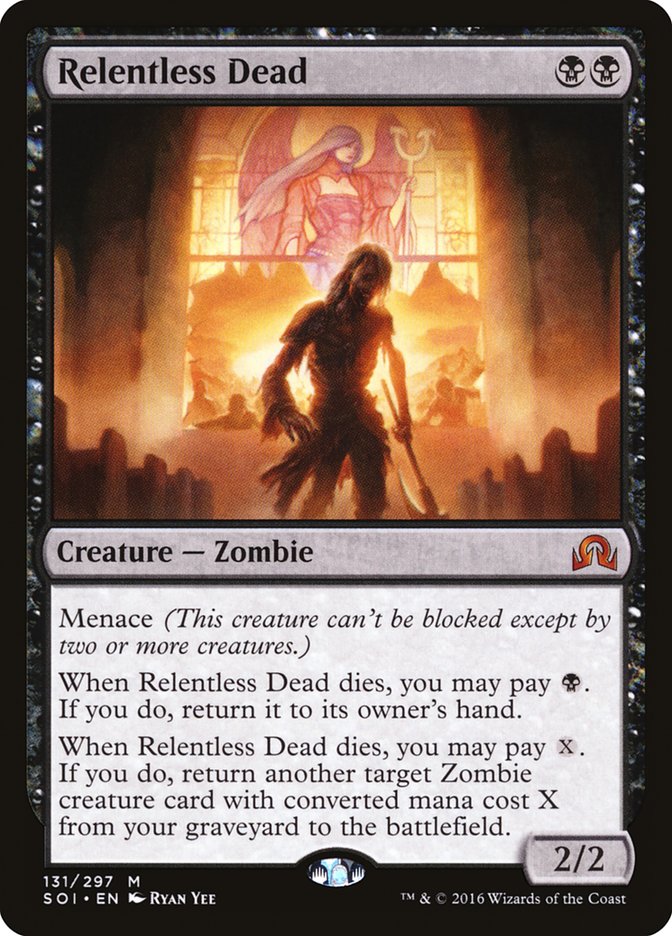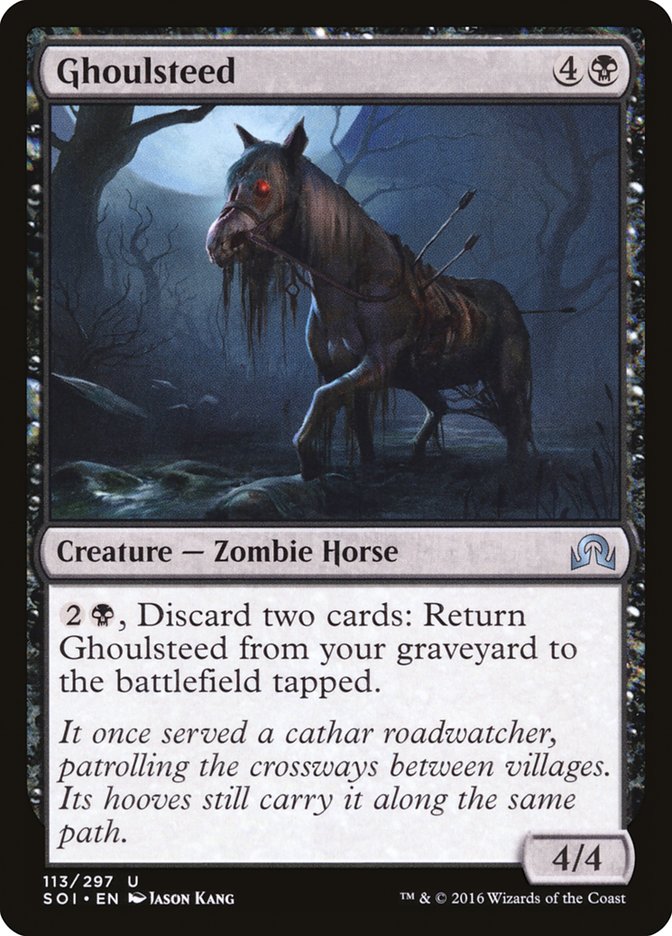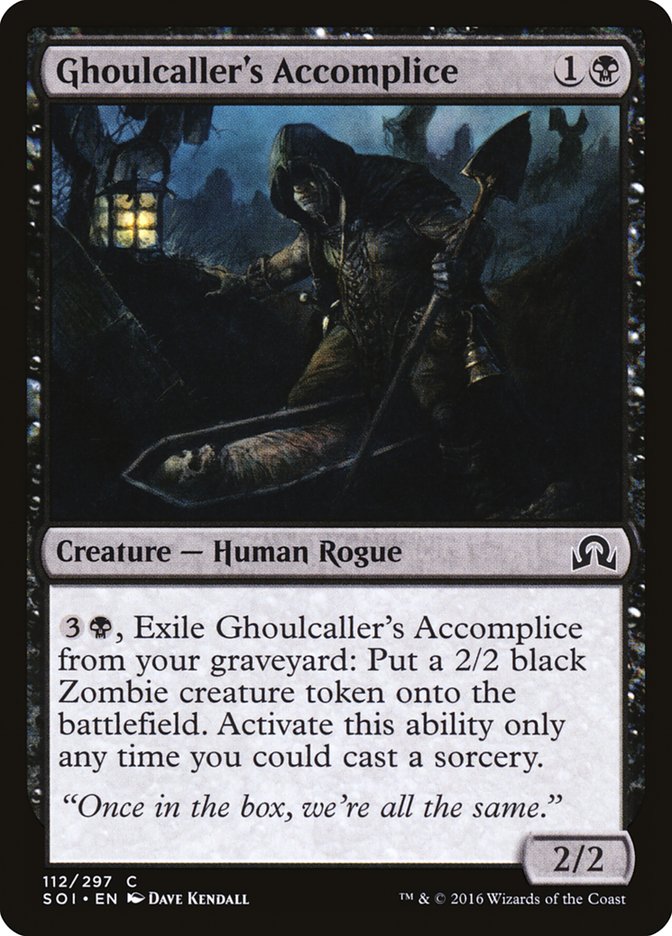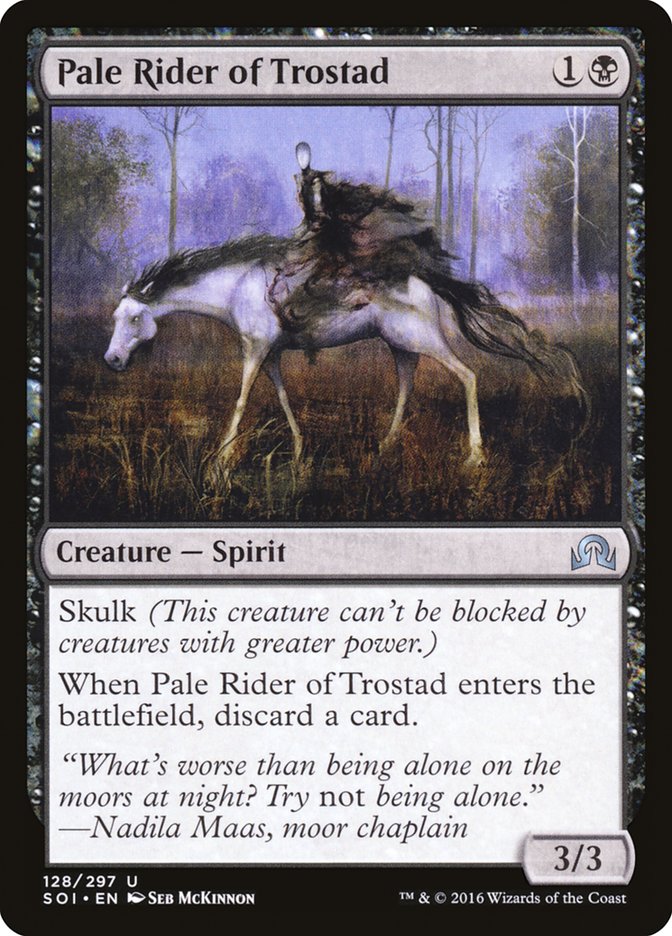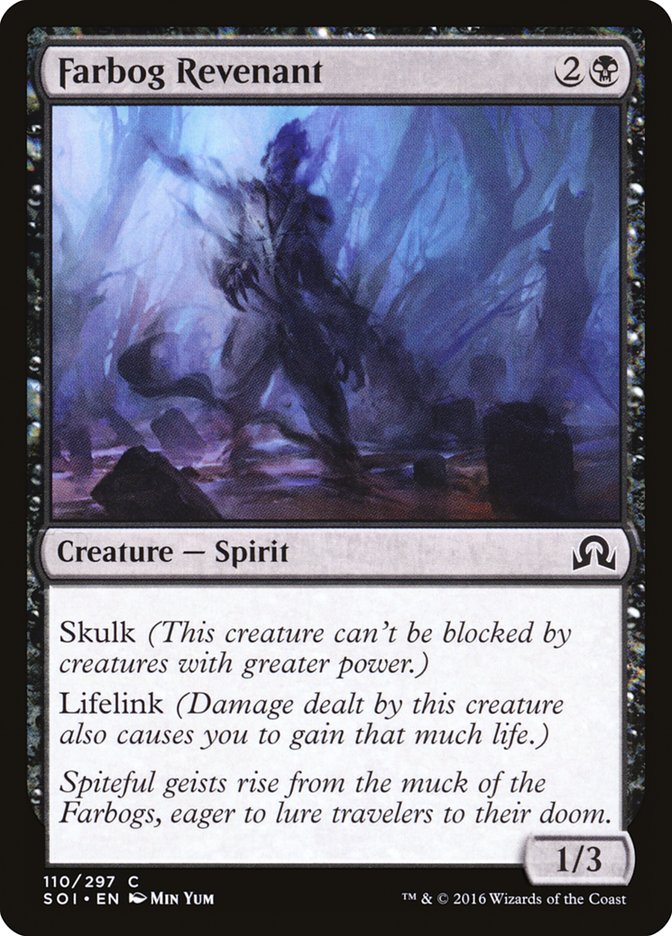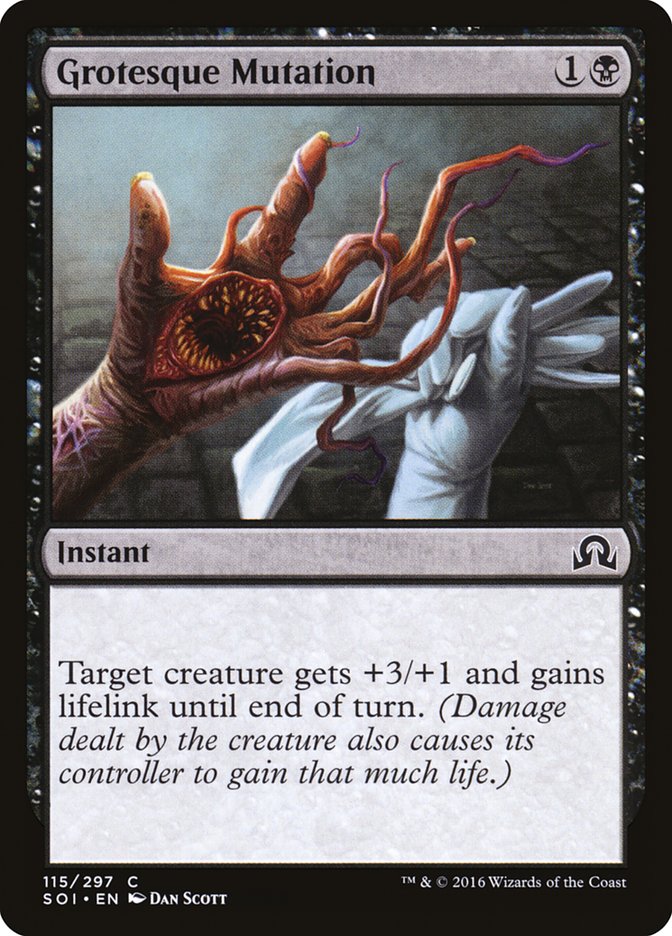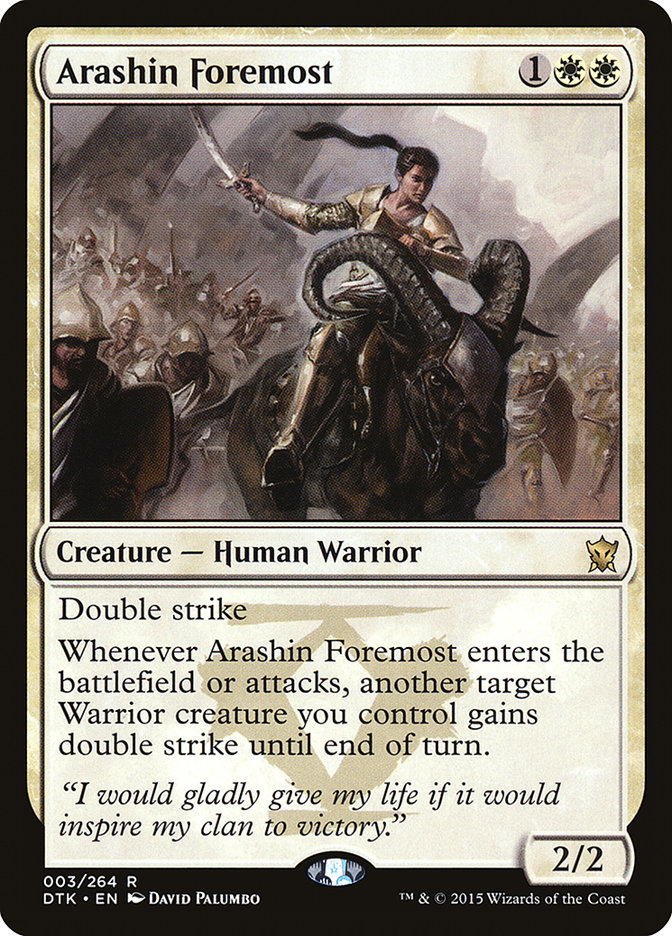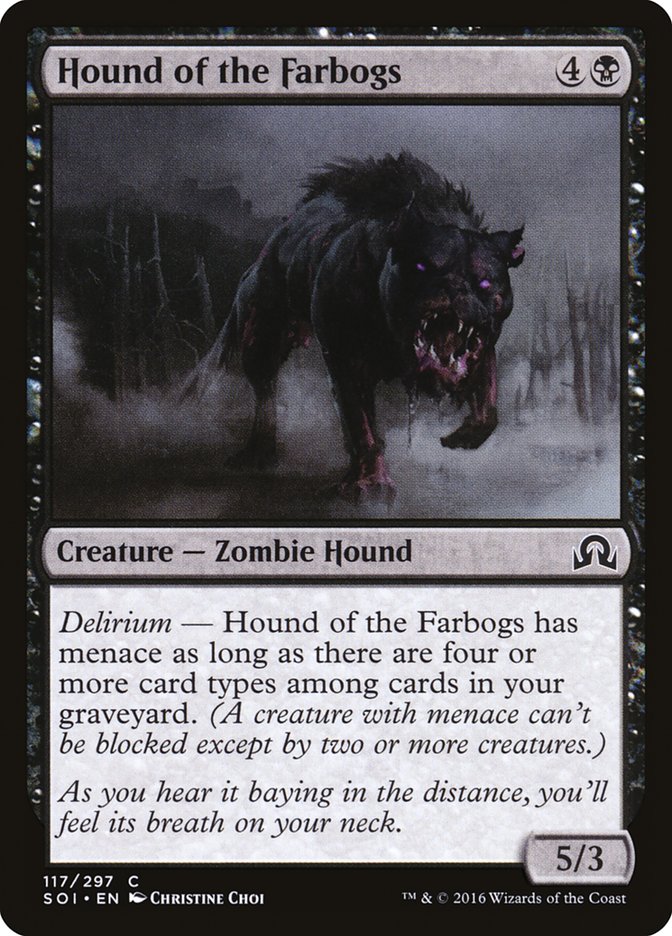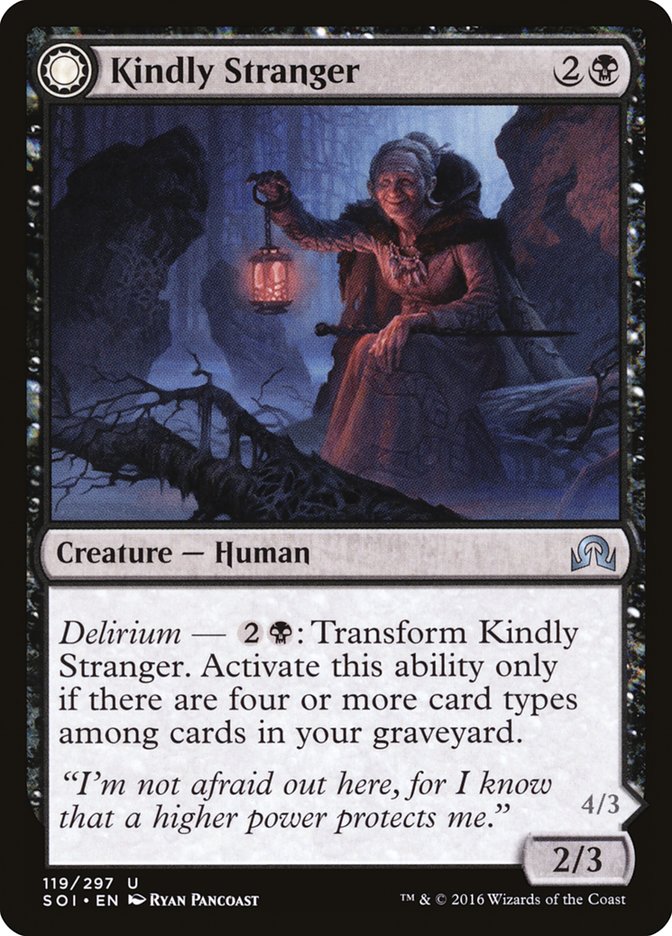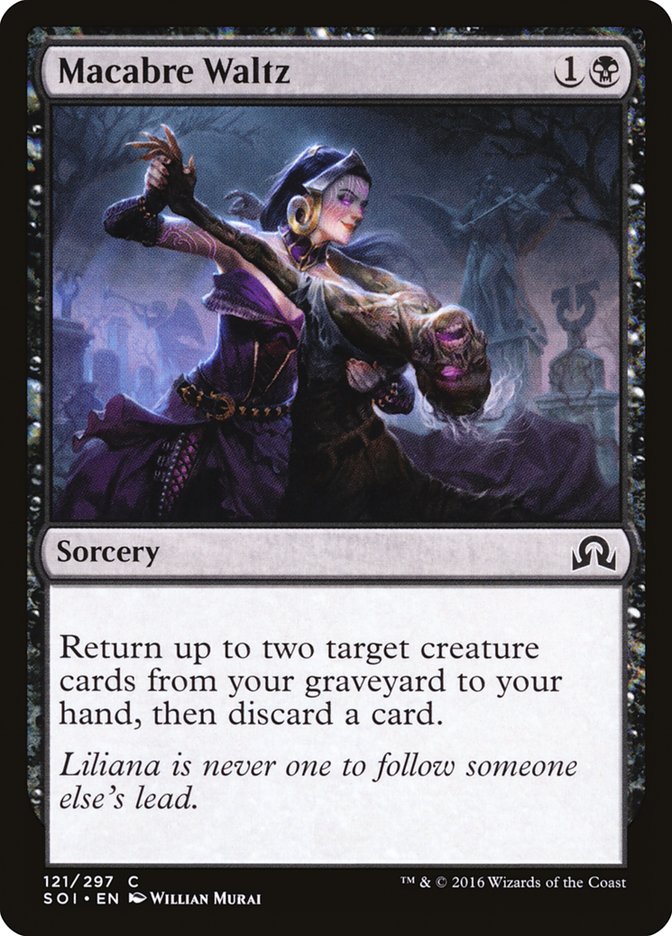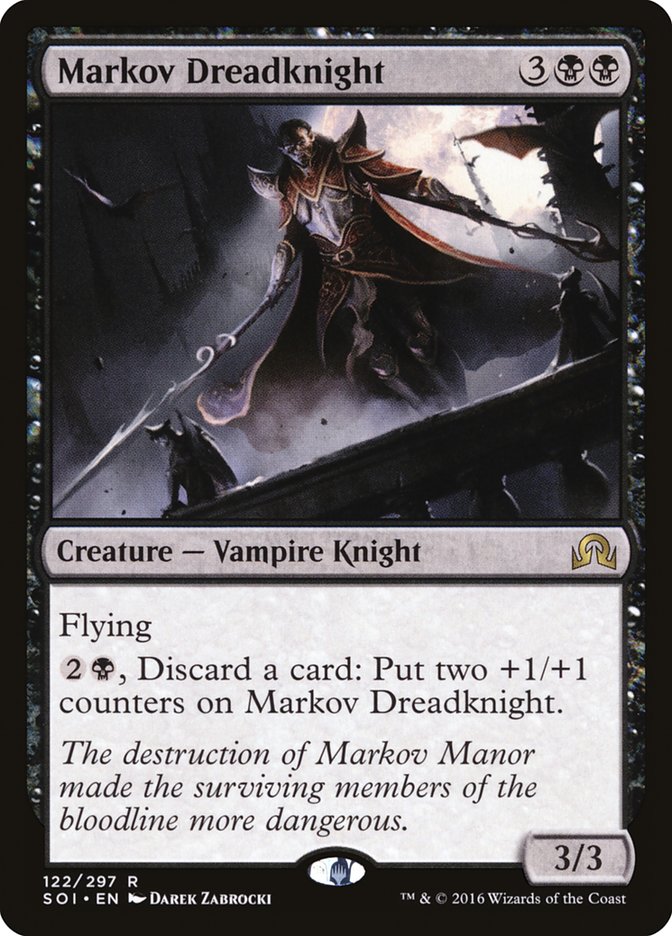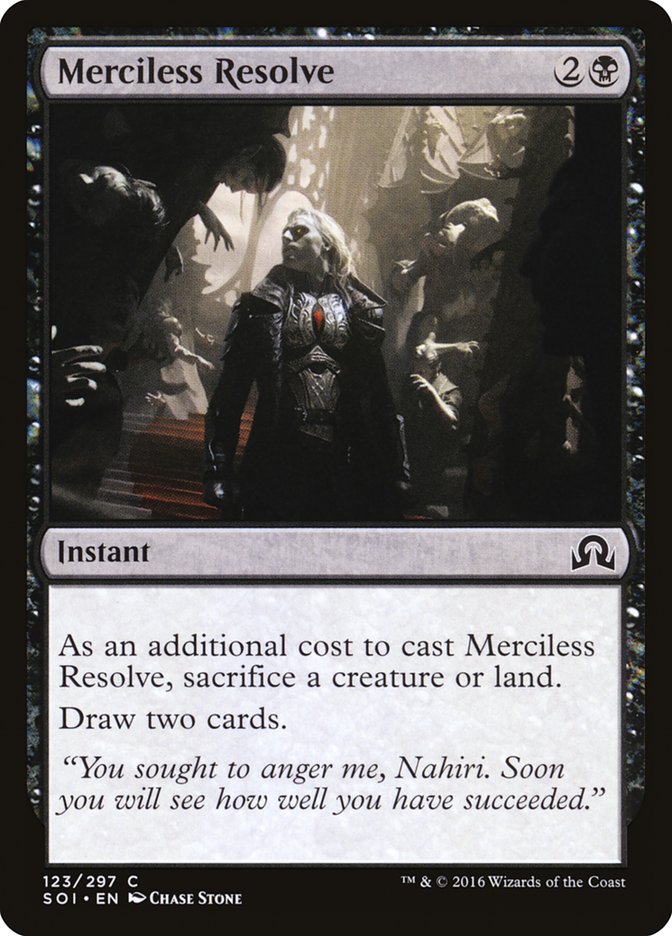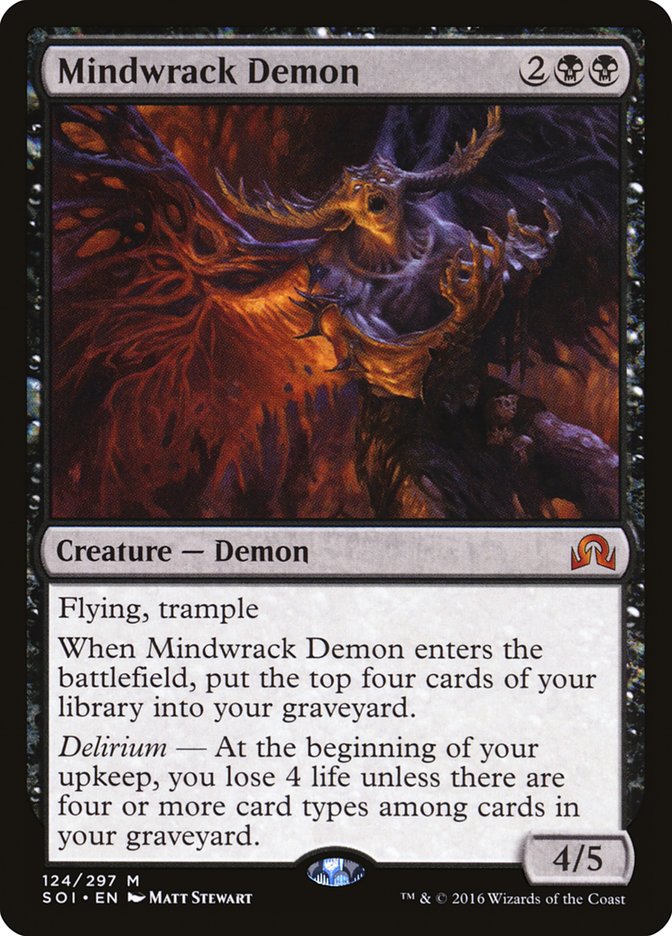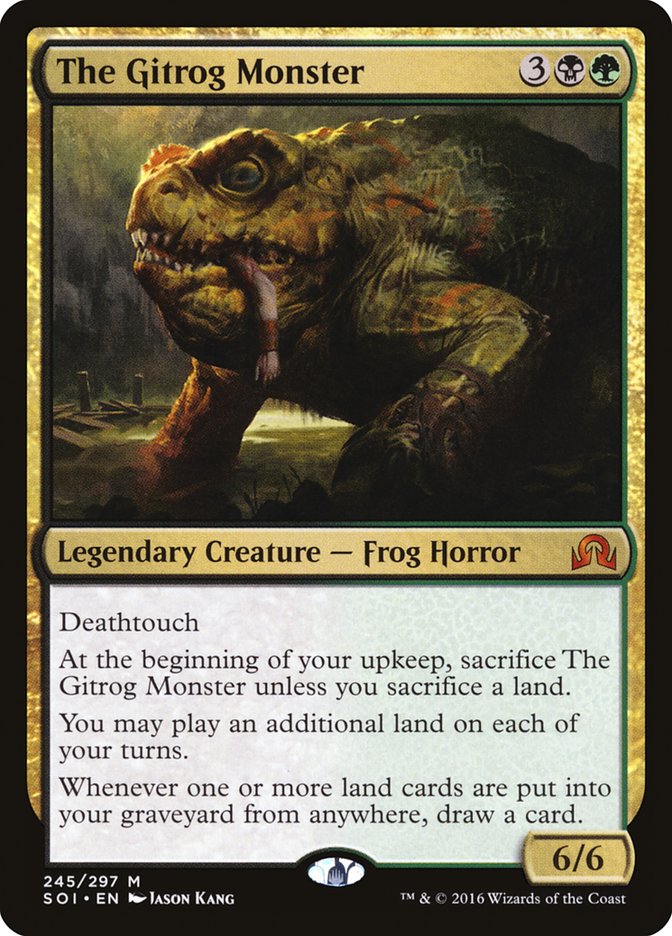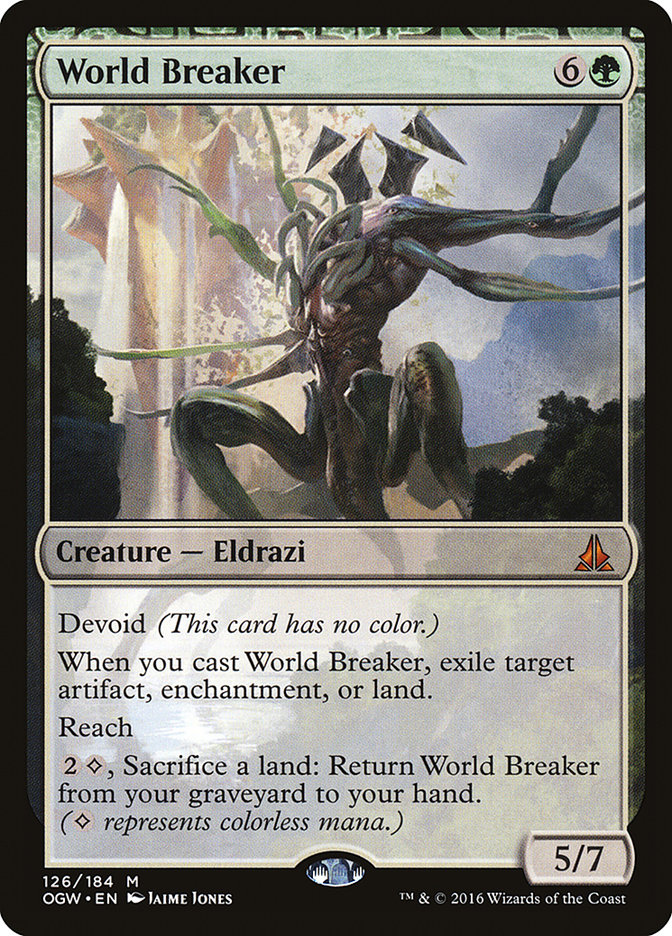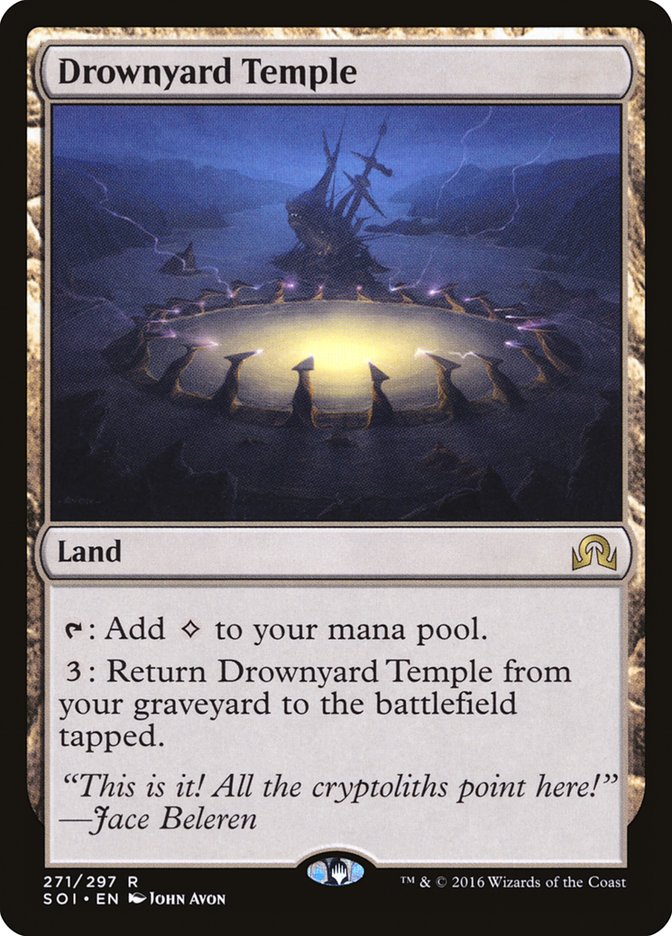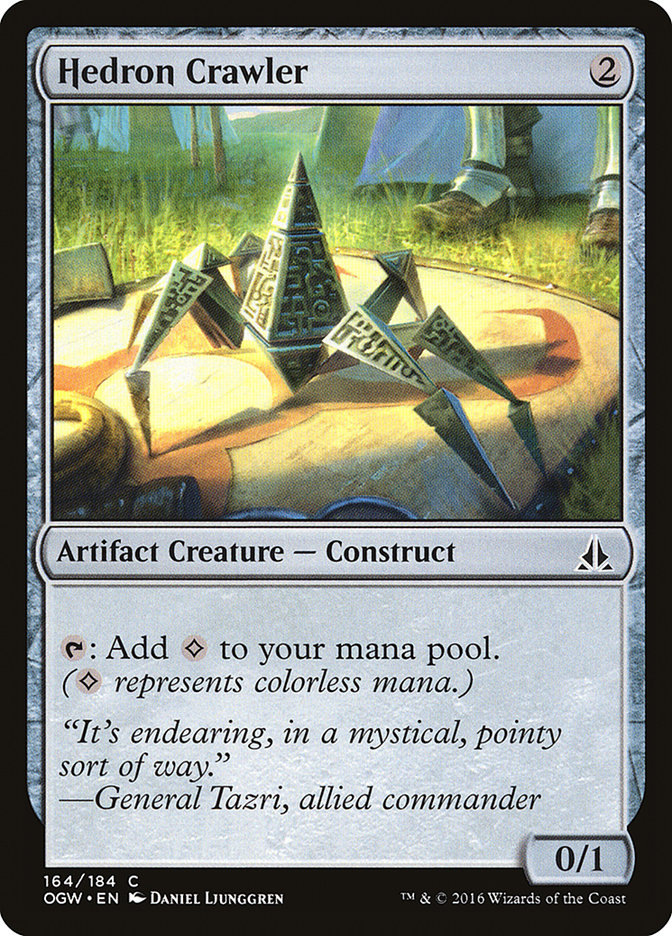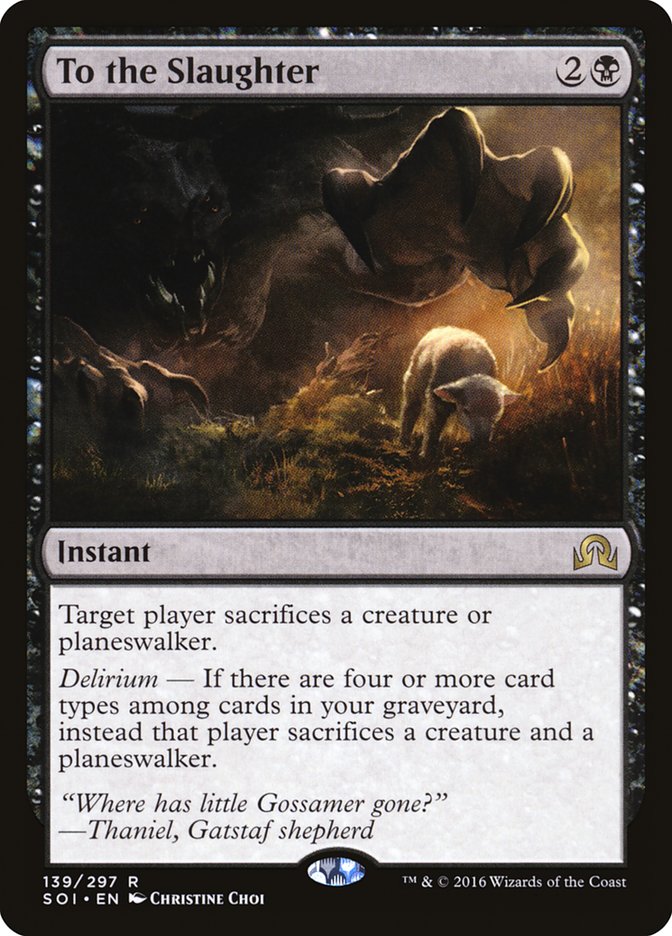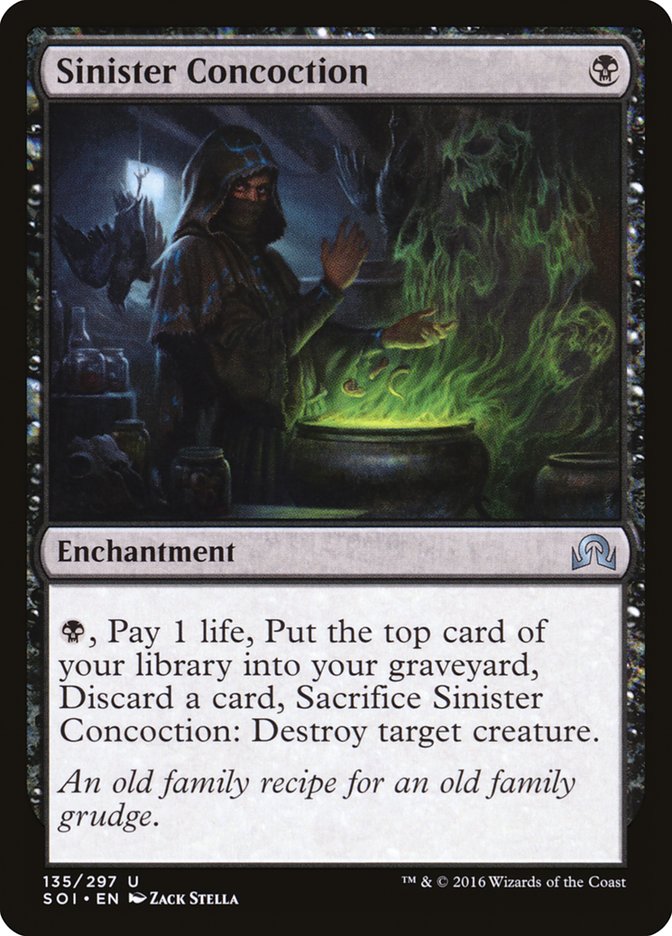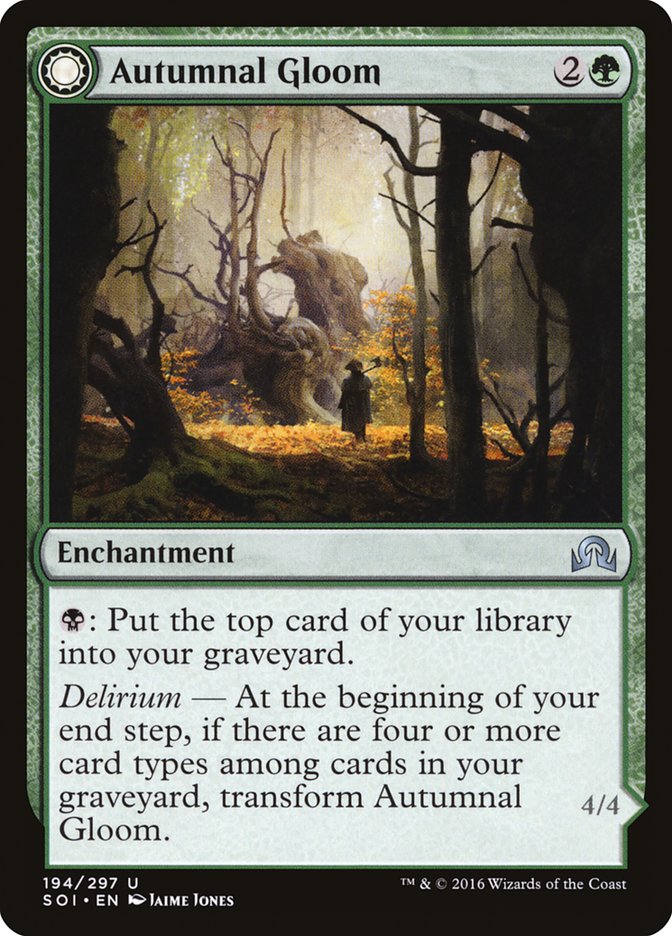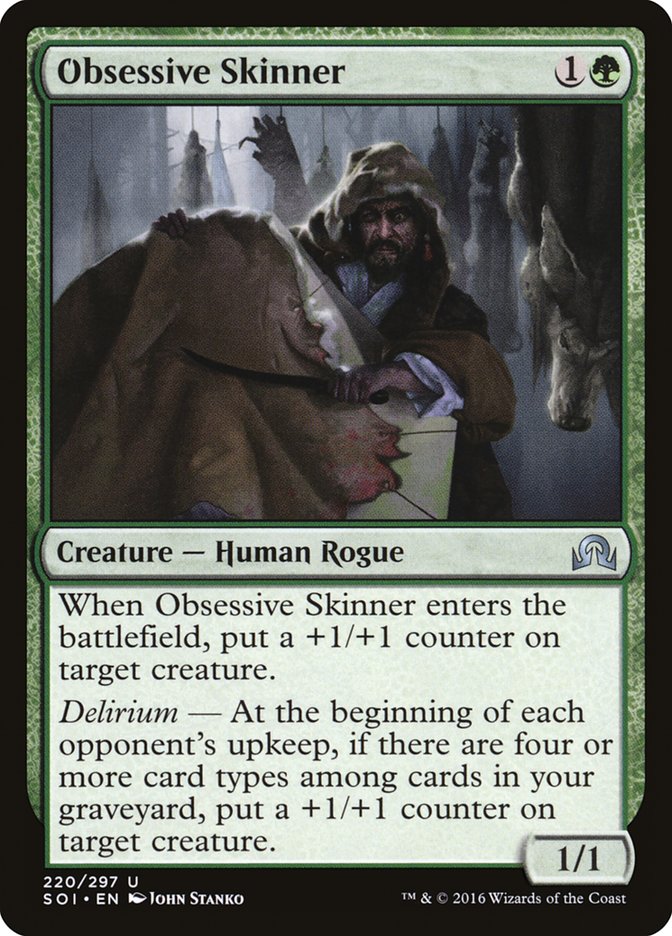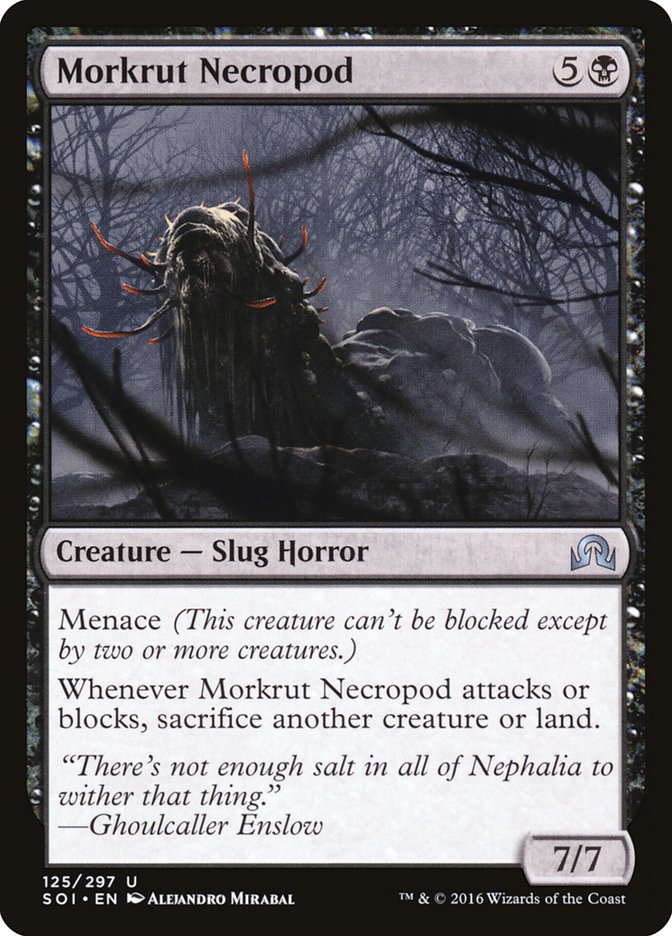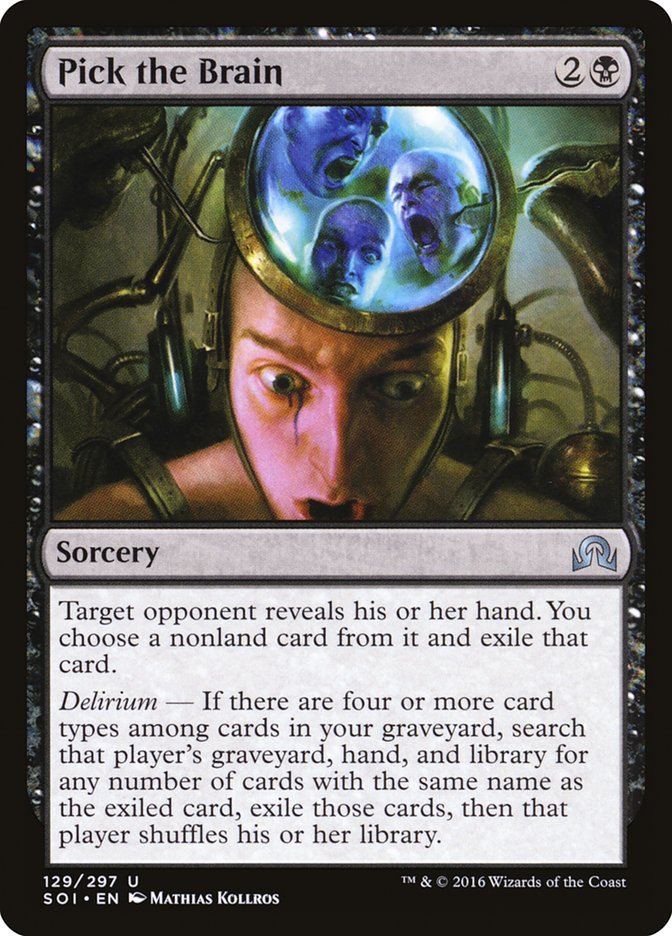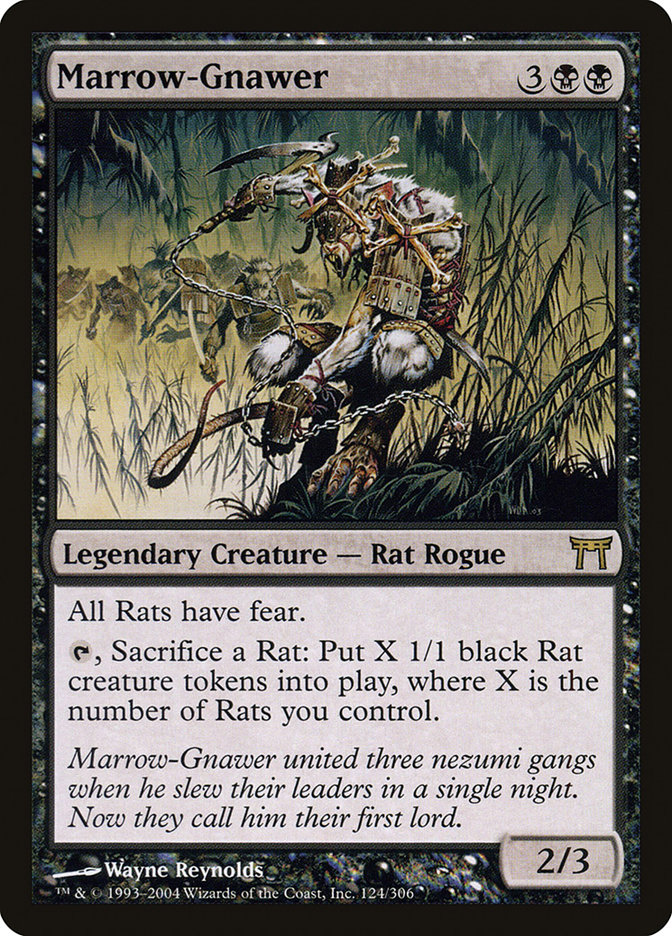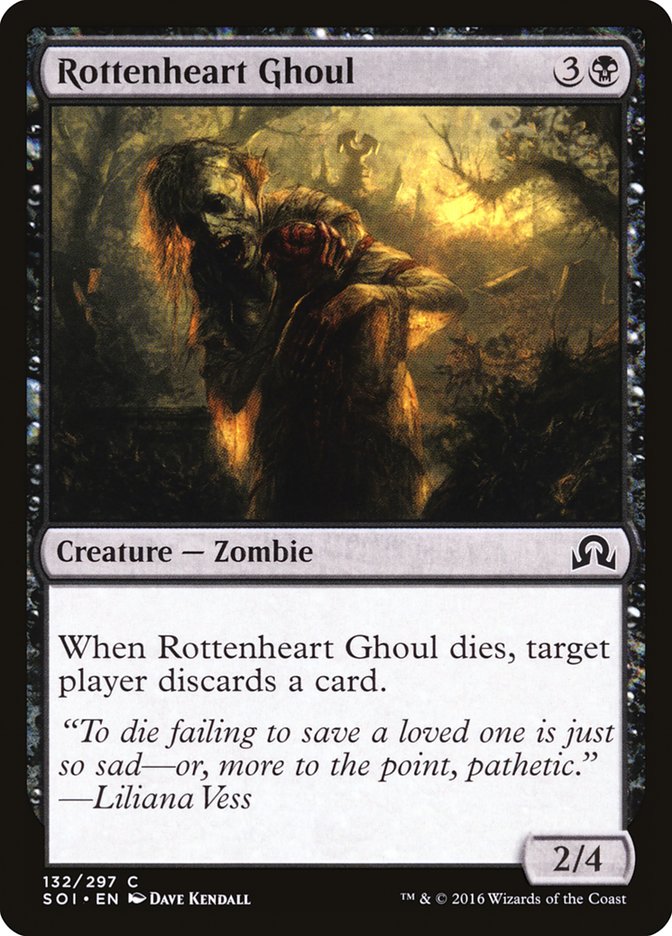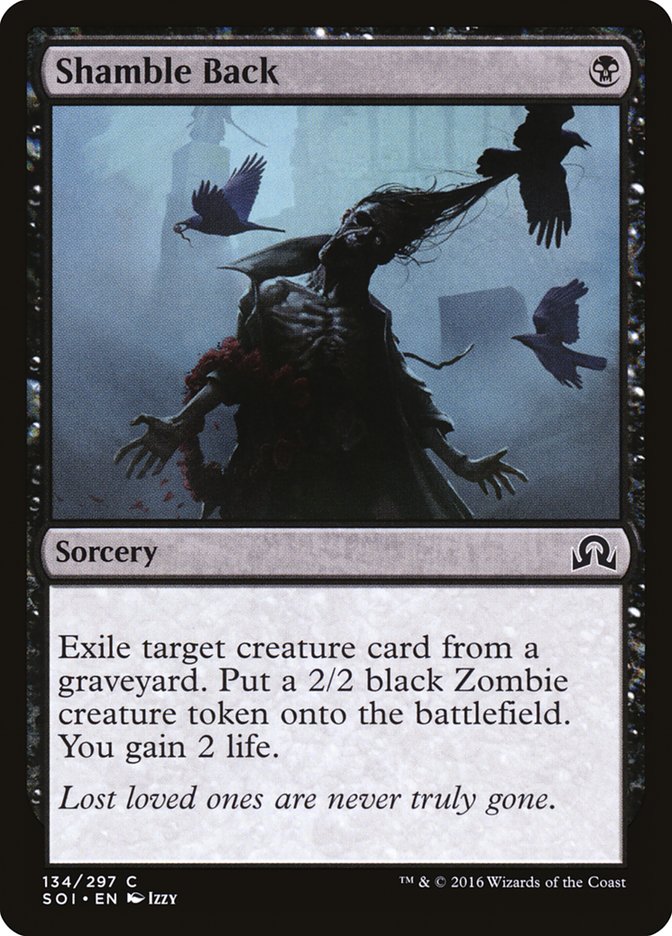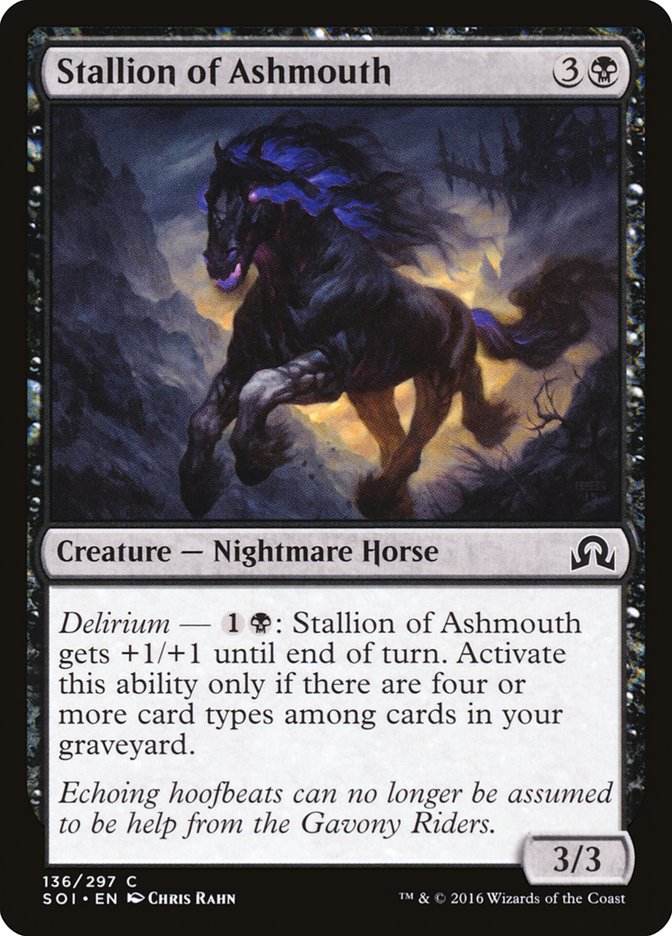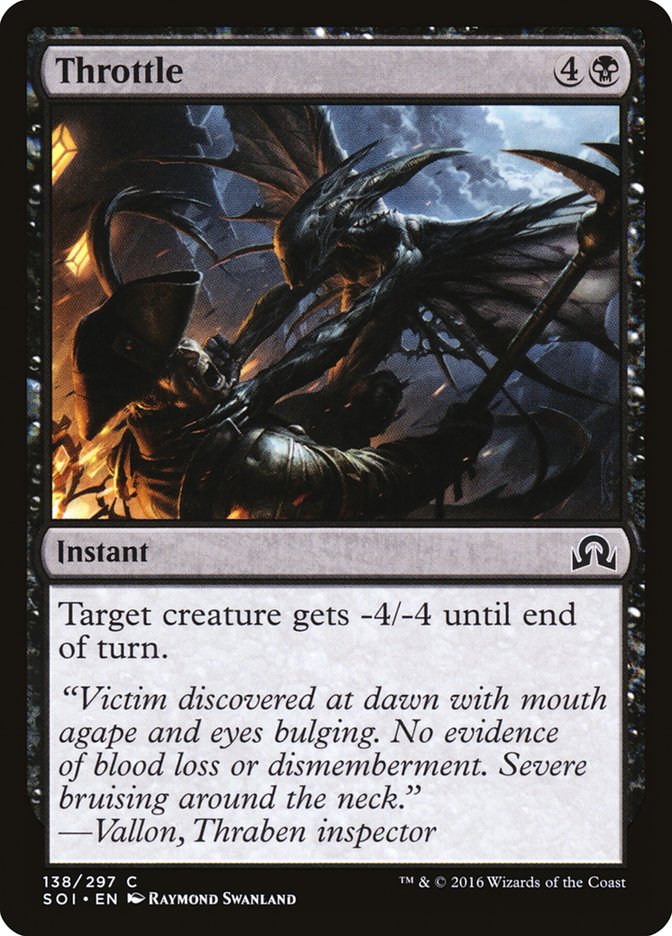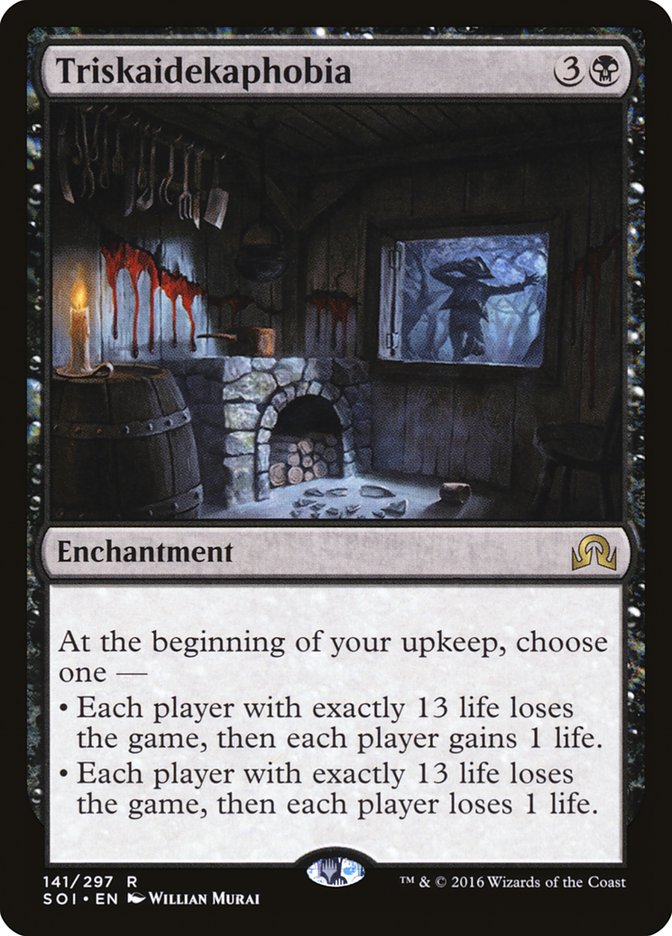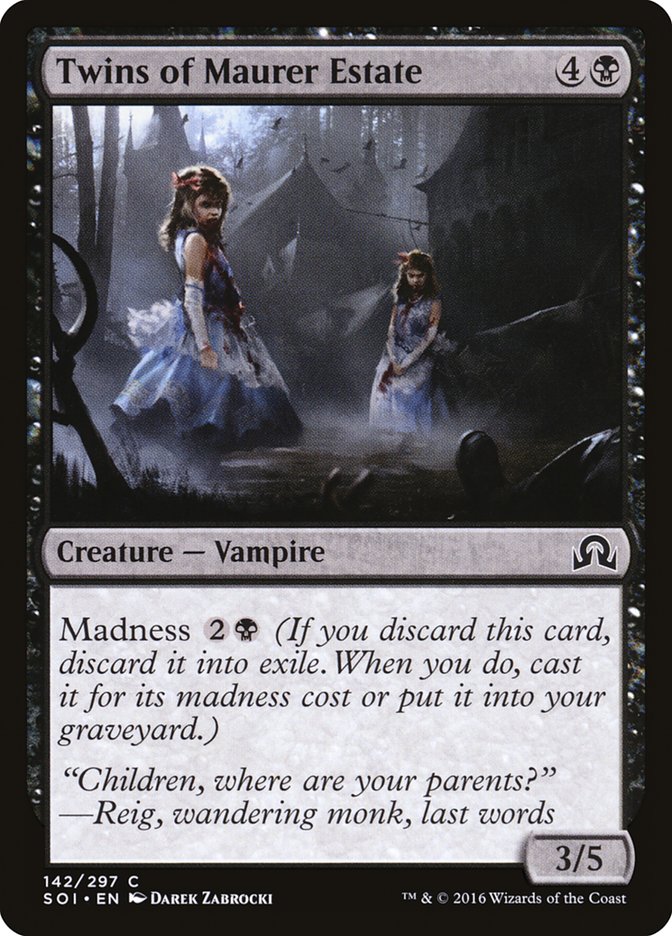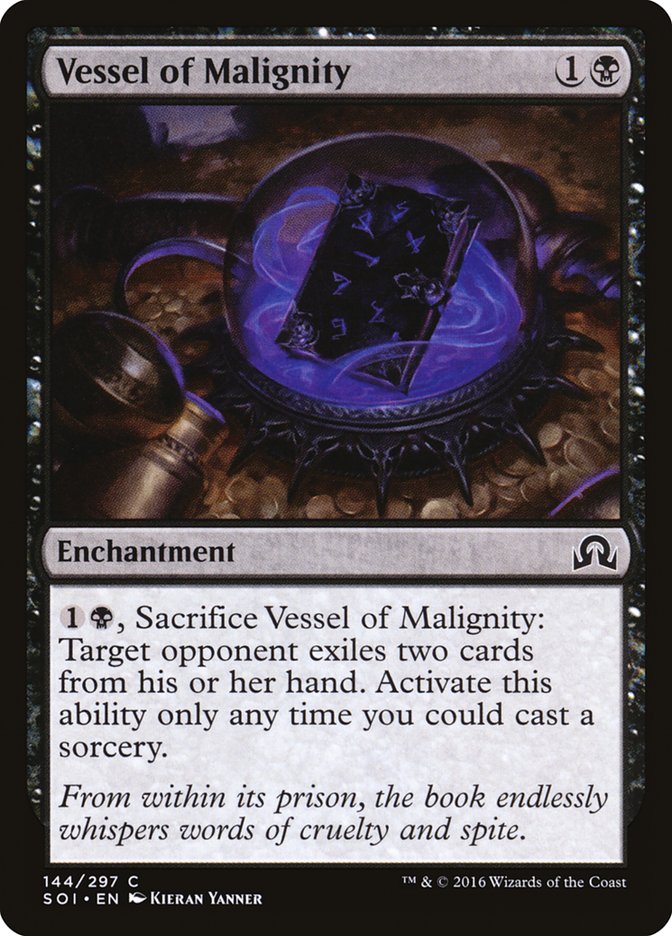And we’re back like Innistrad, this time covering the black cards from Magic’s latest set. Blue can be found here. As always, our focus is on figuring out how to use the new cards so that we have the most number of tools in our toolbox. Let’s go!
Accursed Witch is an oddball. That it lets your opponent target it cheaply is mostly flavor text, though it is pretty brutal that they get to Declaration in Stone it for just one mana (leaving you with nothing). This interaction alone is probably lights out for the Witch, but maybe we can make her work with enough sacrifice outlets.
The curse she inflicts on dying is definitely solid. Even though the cost reduction part is more eye-catching, the “drain for one a turn” ability is the lion’s share of the power. This could give some sort of B/W deck an interesting way to complement a Zulaport Cutthroat / Pious Evangel strategy.
In general, however, I am not overly optimistic about Accursed Witch. There are just so many good four-drops.
Ooh boy. So there are a lot of madness cards and support for madness. One of the things I’ve been loving is how much the designs don’t just all go in the same deck. Alms of the Vein, for instance, is for that madness deck that wants player burn, values lifegain, and has discard outlets worth using…
Here’s one possibility:
Creatures (19)
Lands (22)
Spells (19)

This list uses Alms of the Vein as a glorified burn spell. It’s a little concerning that we’re working so hard to build a better Lava Spike, but the extra damage and life might be able to help us race.
A 3/1 for two doesn’t need to do that much to be appealing. While I’m not super in love with one-toughness ground creatures, Asylum Visitor’s extra card draw combined with cheap madness make me a big fan.
Heir of Falkenrath has a lot going for it. A three-power flier for two is great right now and it even turns on our madness cards. While it can be used immediately (such as on a turn 3 Fiery Temper with our one mana available), it’s also a great card to wait to untap with, since it can let us fire off a big Avacyn’s Judgment.
While Alms of the Vein might be serviceable, here I can’t help but imagine that it might be better suited to some kind of U/B or Grixis tempo deck. I’m not sure what that looks like, but madness cards are very different when you’re looting…
As for the dynamic duo of Asylum Visitor and Heir of Falkenrath, I think a more traditional B/R Vampires deck is probably the better home.
Creatures (26)
- 4 Drana, Liberator of Malakir
- 4 Heir of Falkenrath
- 4 Olivia, Mobilized for War
- 4 Falkenrath Gorger
- 2 Indulgent Aristocrat
- 4 Olivia's Bloodsworn
- 4 Asylum Visitor
Lands (23)
Spells (11)

Olivia’s Bloodsworn is a little bit of a step away from madness toward Vampire tribal, but that’s okay.
Olivia’s Bloodsworn can be a two-power two-drop with evasion, can make for a serviceable three-drop (giving us an extra two damage), and can help us use our mana more efficiently from here on out. When we would spend it all, great. When we would waste a mana, we can trade it for extra damage.
I just love fliers right now and want to get away from ground-pounding one-drops, at least in this deck. The only reason I’m still using Falkenrath Gorger is the added value from its ability. Once you have 26 Vampires in your deck (22 of which don’t have madness naturally), it’s easy to reliably offset the additional costs of Lightning Axe and Heir of Falkenrath, and you can do some pretty great things with Olivia, Mobilized for War. For every Vampire you cast, you can discard another Vampire, leading them all to get +1/+1 and haste.
Olivia is one of the coolest tribal lords in a little while. As a 3/3 flier for three, she’s already a respectable body with much-appreciated flying. That she has such great madness combos makes her high-end pretty high, particularly when you give Drana, Liberator of Malakir haste.
Drana has been a great player on a few bad teams, but she has more reason to succeed on this squad than ever before. With Olivia and her Bloodsworn we’ve got eight ways to give Drana haste, which can be a nightmare for creature-heavy decks, or ones relying on sorcery-speed removal.
It’s important to remember that she has first strike. Not only does this mean her +1/+1 counters to your team come down before regular damage if she is unblocked, she also makes a killer defender in the air when you play her with flash thanks to a turn 1 Falkenrath Gorger and turn 2 Heir of Falkenrath.
Stensia Masquerade is an unusual tribal anthem. It doesn’t give much upfront (just first strike while attacking), but it quickly snowballs hard. It’s particularly effective with our sixteen fliers, making it easier to stack up counters. While it’s handy to have extra options for offsetting costs like that of Lightning Axe, it’s particularly sweet when played mid-combat, letting us blow out opponents not prepared for us having first strike. It’s also nice to stack up some counters on creatures that our opponents would have been willing to block if they had known about the counters.
Why not play more?
While it does technically work in multiples, only one of the two abilities is actually stacking. The ability that does stack is already very snowballing, and when it is working, it is not usually the spot where we need to double down. Where we actually need the help is when we’re not already winning, and Stensia Masquerade is really bad from behind. Drawing multiples could easily be fatal.
I have not maxed out on Indulgent Aristocrat in the list above, but it does have a few things going for it (not the least of which is that it costs black, which is easier to come by on turn 1 for a Drana deck). Lifelink stacks well with +1/+1 counters. The problem, of course, is what to sacrifice?
Maybe it’s enough that you can make blocks hard, that you can sacrifice your non-fliers in some spots and make use of extra copies of legends, that you can fizzle Declaration in Stone and get extra value against removal. I wonder, however, if we’re supposed to be playing with a little bit of dedicated food for the Vampires to feast on?
Creatures (22)
- 4 Jace, Vryn's Prodigy
- 2 Hangarback Walker
- 4 Drana, Liberator of Malakir
- 4 Heir of Falkenrath
- 4 Indulgent Aristocrat
- 4 Asylum Visitor
Lands (23)
Spells (15)

By adding a little bit of a tokens theme, we pick up a bunch of creatures well worth sacrificing for the +1/+1s. Hangarback Walker is a particularly great sacrificial lamb, so maybe we should be maxing out. The problem, of course, is that we are already extremely crammed at the two-spot.
Call the Bloodline is not the most compelling token-maker in the world until you put it in a deck full of madness cards. Now you have a cheap, reliable, and durable way to discard cards for a very real profit (as opposed to Ravenous Bloodseeker, for example, who may just throw them away to pay the madness costs).
The 1/1 lifelink bodies are quite a bit better than generic 1/1s, particularly if you start pumping them with Drana or Indulgent Aristocrat. That we can only use this ability once a turn isn’t a big deal, since we can do it on both our turn and our opponent’s turn. Like Plague Rats, it doesn’t seem like much but creates an overwhelming battlefield position very quickly.
Zombies? In a Vampire deck?
Kalitas, Traitor of Ghet tried to tell you!
Gisa’s Bidding is just deceptively efficient. Even when you pay full retail, you are getting two 2/2s for four mana. Allied Reinforcements is not exactly a bad fail-state, and it’s still two bodies we can sacrifice to Indulgent Aristocrats or just rumble with.
When things are going well, however, Gisa’s Bidding drops down to just three mana and can be functionally a cantrip. Now our turn 2 Jace can add two more creatures to the battlefield on the following turn without dropping even a single card. Additionally, it gives us something to flash back to keep advancing our battlefield (which is much appreciated without something nice like Collected Company).
I’m still not sure how to feel about From Under the Floorboards. After all, it is a slower, less reliable Gisa’s Bidding, and the tokens even enter the battlefield tapped. However, it’s also a major source of lifegain, goes bigger in the fail-state, and has a really high top-end, when we use Call the Bloodline to discard it in the end step and then use the rest of our mana to make 2/2s and gain life.
I’m concerned about how slow it is, as a five-drop (or more) that doesn’t do much to defend us. I’m also concerned about how many token-makers we use that make tokens of the same name, out of consideration for Declaration in Stone. It sucks to have all our tokens swept up without so much as a clue as to what happened.
Murderous Compulsion is a better Assassinate than we normally see, costing one less up front and then having the option to play it at instant speed when we can discard it in combat. It’s hard to play it in a very aggressive deck, when we can’t use it to clear blockers out of the way, though you could potentially combine it with stuff like Stitched Mangler, Bounding Krasis, or Topplegeist to make it more reliable.
Behind the Scenes is probably too mana-intensive for Constructed, but it is cute that, in the world of all square stats, the team Skulk ability ensures the +1/+1 ability is enough to win all one-on-one fights.
We could try it in a white aggro deck, splashing black:
Creatures (26)
- 2 Anafenza, Kin-Tree Spirit
- 1 Dragon Hunter
- 3 Kytheon, Hero of Akros
- 4 Consul's Lieutenant
- 4 Lantern Scout
- 4 Expedition Envoy
- 4 Thalia's Lieutenant
- 4 Town Gossipmonger
Lands (22)
Spells (12)

While the interaction between Incited Rabble and Behind the Scenes is cute (anything back-heavy doesn’t die to one-on-one combat, typically) and Behind the Scenes would do good work for breaking standoffs, this list looks like it would be substantially improved by cutting the four black cards for some Archangel Avacyns, Archangel of Tithes, and/or Gideon, Allies of Zendikar. Then we could better support a bunch of Westvale Abbeys as our standoff-breakers, moving the mana to something like 4 Westvale Abbey and 18 Plains. We even get to take advantage of Westvale Abbey making Humans!
Behold the Beyond basically gives you any combo you want, so figuring out how to win with it is a little like figuring out how to win with Omniscence. It matters, of course; it’s just a very different way of thinking about Magic.
The real challenge is figuring out how to come up with not only the seven mana you (usually) need to cast Behold, but also whatever mana you need to get things going (unless your format has a way to do it for zero, and some powered formats do).
The problem with Behold the Beyond in powered formats is that you could just play Ad Nauseam, or Dark Petition, or whatever. In Standard, however, Dark Petition is not nearly as game-over. I have no idea what the best Behold combo will prove to be, but there are countless to consider.
For instance, you could go get Ever After as one of your three, since Behold the Beyond gives you a way to discard your hand right out of the gate.
Getting back Ulamog, the Ceaseless Hunger and Kozilek, the Great Distortion is fun, but you could also get Dragonlord Kolaghan and Dragonlord Atarka.
What do we need the Behold the Beyond for? A seven-mana discard outlet?
Fair. The point is just that having one Ever After changes things a fair bit in terms of options to tutor for. If you want something more exploitive of Behold the Beyond, how about Seasons Past?
If one of the cards you go get is Seasons Past, you can get back basically anything you discarded, whatever you tutored for, and the Behold the Beyond, surprisingly doesn’t exile itself.
Behold the Beyond is the exact kind of card that is super-hard to build around, super-hard to make work, and usually doesn’t work out, but if you get there, it is a triumph of deckbuilding and provides real edge. Sometimes, these big crazy combo cards are Dragonstorm or Tooth and Nail.
Rising Miasma has already seen play a number of times, so it’s very likely that Biting Rain will too. It’s a major, major strike against it that you can’t use Jace to madness it without killing the Jace (since discarding a madness card never flips Jace, even if you don’t want to pay the madness cost, because madness automatically exiles the card first).
Still, -2/-2 is a real thing, particularly when you have 2/3s and 3/4s you want to live through it that would not live through Languish; and maybe don’t want Flaying Tendrils because of something like Hangarback Walker. The biggest upside, though, is getting to cast it at instant speed when you have a discard outlet. Being able to surprise your opponent with a -2/-2 after they end-step Secure the Wastes is potentially game-winning, even if you lose your Jace. Besides, maybe you are playing something like Call the Bloodline, which would give you the 1/1 Vampire after the Biting Rain has subsided.
This is a very slow form of disruption, and they get away from the life loss by playing out their hand. It’s not inconceivable that a deck with graveyard or madness synergies could want this out of the sideboard, but it’s not likely.
The Crow is the right creature type, triggers on the way in and the way out, and has flying. I’m not totally sure we can dismiss this card for Constructed. It might be a sweet way to help stock our graveyard with Relentless Deads and Prized Amalgams, or maybe just get delirium online faster. The real problem is that we have an embarrassment of riches for options at the three-spot, so it’s hard for a glorified Feral Shadow to get a starting spot.
A very respectable removal spell, Dead Weight’s value hinges on three things:
● How much do you value saving a mana, compared to other options?
● How many creatures besides Jace die to it?
● How much do you value delirium?
Just as Fiery Impulse took a little bit to reach widespread adoption as a four-of, I would imagine Dead Weight starts in small numbers and increases later as the format speeds up (since people’s decks get tuned).
I love how many of the build-arounds in this set are designed in ways that are rich and deep, rather than just “play all the [insert label here] you can and give them +1/+1.” Geier Reach Bandit rewards Werewolves by flipping them early. Indulgent Aristocrat gives your Vampires +1/+1 each time but needs to eat something, so you can play some non-Vampires without losing value. Spectral Shepherd lets you blink your Spirits, which is very different on Spirits with enters-the-battlefield triggers, while actually discouraging you from playing Spirit tokens.
Diregraf Colossus obviously pushes you to be very heavily into Zombies, but it doesn’t actually reward you for playing the Zombie-token-makers. It rewards you for stalling the game out a little, so that it has time to take over, but it makes tokens that are tapped, so you can’t always count on it for defense in the short run. It actually puts a lot of tension on you and is not going to be easy to maximize in deckbuilding or in games.
In terms of the rate, it takes only two Zombies in your graveyard, or a single Zombie to follow, to give us a quality amount of body. Often, it’ll start out huge and create a dominating battlefield presence if unchecked. If there is a reason to be all-in on Zombies, this is probably it.
We talked about a B/U Zombie deck a bit on Tuesday, so let’s try our hand at a Sultai one today, bending things to support Collected Company:
Creatures (29)
- 2 Nantuko Husk
- 2 Fleshbag Marauder
- 4 Sidisi's Faithful
- 4 Jace, Vryn's Prodigy
- 3 Despoiler of Souls
- 4 Relentless Dead
- 4 Diregraf Colossus
- 4 Prized Amalgam
- 2 Stitched Mangler
Lands (24)
Spells (7)

While this list has just eighteen Zombies, it’s going to feel like a lot more because of the Jaces and Collected Companies. Besides, we’re not really trying to be a Zombie deck so much as a recursion deck.
Prized Amalgam doesn’t need us to be Zombies to do its trick. For instance, Despoiler of Souls is a fine combo with it. Just make sure to start by exiling extra Jaces and Sidisi’s Faithfuls so as to not hurt your Diregraf Colossus unnecessarily.
One Zombie that works particularly well with Prized Amalgam is Relentless Dead:
We’ve talked about Relentless Dead at length over the past month, but suffice it to say, it’s quick and strong, assuming you can cast it, have plenty of ways to sacrifice it, and have Zombies worth getting back. That it has menace is actually quietly very important, particularly for pressuring planeswalkers early.
Fleshbag Marauder and Nantuko Husk are sweet Zombies that can sacrifice the Relentless Dead for value, but Sidisi’s Faithful is actually super-nice as well. Because it costs just one, you can reliably sacrifice the Relentless Dead, pay the B to get it back, and pay the three to get back your Diregraf Colossus (which, in turn, gets back Prized Amalgam). You even get to bounce something and have a 0/4 in play to help defend you, not to mention a Relentless Dead in your hand to start making Zombies with.
Now, here’s the fun part…
You can Sidisi’s Faithful your own Sidisi’s Faithful!
Now, you can Relentless Dead with buyback any of your other Zombies!
Yes, you are building an awkward Nantuko Husk, but it’s another option that could be very exciting against sorcery-speed removal and sweepers, and we’re getting it for playing a card we might want to play anyway.
Another possible avenue to go with this style of deck is toward Deathmist Raptor and Den Protector, making it even more advantageous to dump cards into our graveyard. Still another is to incorporate recursion along the lines of stuff like Ghoulsteed.
Ghoulsteed is a curious card, giving us a reliable way to get back a Zombie from the graveyard at instant speed, potentially by surprise. Just imagine a turn 2 Jace or Heir of Falkenrath, followed up by a turn 3 Ghoulsteed discarded and then returned. You can actually discard Prized Amalgam as part of the cost of returning Ghoulsteed and have it in the graveyard in time to return to the battlefield when the Ghoulsteed comes back!
Turn 2 Heir of Falkenrath into Ghoulsteed, discarding two Prized Amalgams, is thirteen power on turn 3, and that’s not even counting if you had a one-drop. What’s more, most of it could be played during your opponent’s end step if you didn’t want them to know what you were up to!
Okay, so you crash for thirteen and then get wrecked by a Languish. Game over, right?
Right.
For them.
You can just play three mana again, discard two more cards, and return ten power to the table, finishing your opponent off! Seeing the recursive power of Prized Amalgam and Ghoulsteed helps make clear why Declaration in Stone is so crucial. It also helps shine a spotlight on Nantuko Husk and its ability to fizzle such things.
There are lots of other cards we can discard to Ghoulsteed besides just straight-up madness. Stitchwing Skaab and Geralf’s Masterpiece get a discount from being played out of the graveyard anyway and provide more ways to fuel Prized Amalgam. Some cards have an exile condition in the graveyard, like Ghoulcaller’s Accomplice:
Ghoulcaller’s Accomplice is a very modest card, but it is dependable, reliable. It’s the sort of card a person that appreciates Carrier Thrall might be able to appreciate. It’s nice that we can discard it to stuff early, without having any extra mana, and still get the value. This makes it ideal with cards like Pale Rider of Trostad.
Pale Rider of Trostad alongside Heir of Falkenrath, means we can reliably play a three-power creature on turn 2 that gets Ghoulsteed into our graveyard. Pale Rider of Trostad is also not trivial to block, even if Skulk on a three-power creature is only medium. At least Avacyn doesn’t block it!
Pale Rider of Trostad discarding Ghoulcaller’s Accomplice doesn’t actually “save” us mana the way discarding Ghoulsteed does. This, combined with the Accomplice not being a Zombie upfront, has me skeptical that it will pan out.
Elusive Tormentor may look like a Vampire madness outlet, but it’s also an odd sort of Aetherling. You typically play it with one mana open, and then, if someone tries to kill it, you can discard a card to turn it into a 0/1 indestructible, hexproof creature.
Once it’s in Mist form, you have to attack to turn it back. The good news is, your Insidious Mist is unblockable, so when you pay the three to flip it back, you get in for four damage. That you can threaten to do this means Elusive Tormentor is always potentially four points of unblockable damage for the purposes of racing.
It’s important to remember that Insidious Mist cannot block. This means that if you are counting on Elusive Tormentor as a defender, your opponent can “waste” a removal spell on it, flipping it, and making it no longer able to block. Additionally, it needs to attack to flip back, so it won’t be blocking next turn, either. All of this adds up to suggest that Elusive Tormentor is much more about attacking than blocking.
Not enough rate and poor allocation of stats and abilities for Constructed.
A much better Giant Growth than black normally gets, so it’s worth keeping this one in mind. Lifelink pays you double for the bonus to strength anyway, so if we find a deck with more pump spells and multipliers, this could be part of the puzzle. For instance, imagine Grotesque Mutation on Scourge Wolf, particularly if instant is the fourth card type that turns on delirium. Not only do we get double the bonus damage because of double strike, we get double the lifegain for a twenty-point swing.
While most of the double strike is in red/white, making such a marriage unlikely, there is one card that might give us reason to employ the double strike + Grotesque Mutation combo.
Arashin Foremost has double strike naturally and grants it to Warriors. Historically, there have been a few W/B Warriors decks, so it’s definitely possible. Of course, there are also some sweet Warriors in other colors now, too. For instance, green offers Surrak, the Hunt Caller and Duskwatch Recruiter. Surrak is a great Warrior to give double strike to, and even on an empty battlefield, Grotesque Mutation makes him big enough to attack with haste (and lifelink!).
Too bad a rate for a card that doesn’t do anything besides attack and block.
I could actually see this one potentially getting there, even if it’s a bit of a long shot. It’s a bit expensive and clunky, but the flip condition is easy to set up and lets us build a reasonable Nekrataal. Sometimes you just want a creature to Traverse the Ulvenwald for that can kill any creature, so maybe we could play it as a one-off tutor target.
If the Level 0 is using this as a finisher in a creature-heavy deck, the Level 1 is making it a creature deck full of recursive creatures to take advantage of the self-mill.
Of course, the Next Levelis to cast it after you end-stepped Gravepurge…
.
.
.
Seriously. It could happen.
.
.
.
I guess Macabre Waltz could be a madness enabler, or another way to get a card into your graveyard you want. The problem is making sure you have two creatures worth getting back. Because of how unreliable it is early on, particularly in a format full of cards like Declaration in Stone, I’m not into it.
Sure, this can take over a Limited game and has synergy with several mechanics. It’s just too mana-intensive for Constructed.
It’s not like we’ve got all these decks with four Altar’s Reaps and just wish we could get more so badly that we’d be willing to pay a premium. That said, it does sacrifice lands too, which is something. There are a number of ways to profit from lands going to the graveyard, not to mention wanting to recur lands like Mortuary Mire with anything that lets you play lands out of your graveyard. That said, Merciless Resolve is one-shot and horribly inefficient.
Now, if we could sacrifice Demonic Pact, we might be getting somewhere…
Mindwrack Demon is awesome! A 4/5 flier for four is actually super-conveniently positioned. It lives through Languish and doesn’t die to Archangel Avacyn, though we do have to be careful about Lightning Axe.
Mindwrack Demon’s drawback of “deal four damage a turn to you” is not hard to overcome if you build your deck toward delirium. Once you do, Mindwrack Demon becomes amazing, since it actually tends to get you to delirium instantly (or very quickly).
We can use Mindwrack Demon as just a 4/5 flier with upside, but there are even more ways to take advantage of it…
Creatures (26)
- 1 Dragonlord Atarka
- 3 Den Protector
- 4 Deathmist Raptor
- 1 World Breaker
- 1 Mina and Denn, Wildborn
- 2 Hedron Crawler
- 4 Mindwrack Demon
- 4 Deathcap Cultivator
- 1 Tireless Tracker
- 4 The Gitrog Monster
- 1 Kindly Stranger
Lands (22)
Spells (12)

The Gitrog Monster is a super-cool fatty that really rewards some weird stuff.
The Gitrog Monster’s “drawback” of requiring you to sacrifice a land each turn is actually upside (most of the time), since you are getting to loot away lands. You can even get ahead of it by playing two lands a turn (which you may draw, given how many extra cards it’s drawing you, if you are doing it right).
● If you have The Gitrog Monster on the battlefield, Mindwrack Demon’s “mill four” suddenly draw you a card most of the time.
● Evolving Wilds draws an extra card.
● Corpse Churn, of all things, draws us a card most of the time. We need instants anyway, and it also turns all of our other self-mill into some amount of selection.
● Tireless Tracker pays us even more extra cards from all these lands we’re playing. Not only do we get paid double for Evolving Wilds, we get extra clues from the extra lands both The Gitrog Monster and Mina and Denn, Wildborn are letting us play. Even if we don’t crack them all immediately, they can make for a nice insurance policy if things go south.
● Mina and Denn, Wildborn let us play even more extra lands (and when we start going off, we’re gonna draw a lot). They also let us bounce lands, like Mortuary Mire, to get their ability again. Hissing Quagmire becoming a Blinking Spirit is kind of exciting. All these land tricks are cute and all, but we also appreciate the trample, particularly on The Gitrog Monster, since deathtouch means almost all the damage is going through, even when they chump.
Kind of nice to eventually mill World Breaker for even more inevitability and problem-solving capabilities. Sacrificing lands to get it back triggers The Gitrog Monster even more, and sacrificing Drownyard Temple to either one is the road to sweet, sweet value, since we can just get it back by paying three mana.
Drownyard Temple, Llanowar Wastes, and Hedron Crawler aren’t a ton of colorless sources, but we won’t need one until late, and the Temple jumping out of the graveyard means we never even have to draw one if we mill enough.
An important delirium enabler, it’s actually not clear what the split should be between Deathcap Cultivator and Hedron Crawler, but deathtouch is nice, and the Cultivator makes it much easier to cast a turn 3 Mindwrack Demon.
To The Slaughter is often a control card that values planeswalker removal and Edict effects. Here, we get delirium so easily we can make use of it anyway despite it not being a reliable way to interact with the creatures we care about. We need a few instants for delirium anyhow, and it does give us some options for stopping planeswalker ultimates late.
Another direction we could go with Mindwrack Demon is something a bit more aggressive, less ramp-y:
Creatures (22)
- 1 Den Protector
- 4 Mindwrack Demon
- 4 Deathcap Cultivator
- 4 Obsessive Skinner
- 1 The Gitrog Monster
- 4 Inexorable Blob
- 4 Moldgraf Scavenger
Lands (23)
Spells (15)

This list is really more of a Dredgevine deck, shoving all-in on delirium and getting extra value for having it early and often.
Sinister Concoction is mana-efficient hard removal that usually gets you all the way to delirium by itself. It’s important to remember that you get to mill the top card of your library before deciding what to discard, but once you mill that top card, you can’t back out. This means you can see if you just milled a land or a creature or whatever before deciding between discarding a two-drop or a land, making it much easier to get delirium.
Autumnal Gloom is one of my favorite cards in the new set. When you have delirium, it immediately turns into a 4/4 trample hexproof creature for three mana, which is awesome. If you don’t have delirium, it can usually achieve delirium for you very quickly.
Comboing it with The Gitrog Monster is a good time, and I could imagine a deck full of graveyard recursion creatures in the Deathmist Raptor to Prized Amalgam space really getting into such a thing. As if all this wasn’t enough, it’s even an enchantment, so that when you flip it to Mindwrack Demon, you are that much more likely to tron up.
Obsessive Skinner is particularly sweet with Autumnal Gloom, since the Gloom ensures we have delirium for the Skinner and the Skinner immediately puts a +1/+1 counter on the Gloom during your opponent’s upkeep, growing it too large for Languish to kill.
I’ve actually got quite a bit more to say about the various green cards in this deck, but we’ve got to save something for Part 3!
If the metagame gets to the right place, I could imagine a place for Tooth Collector in delirium decks. Its enters-the-battlefield trigger would be particularly nice against 2/1s for one, 2/1 fliers for two, and a variety of tokens. Even if we’re not killing something outright with it, it shrinks a creature every turn on their turn, preventing some damage and some attacks.
So why aren’t you playing any?
Jace has two toughness.
You have to value this ability as upside for Morkrut Necropod to be appealing, as a 7/7 vanilla isn’t close to Constructed. Even though there are a variety of creatures worth sacrificing and cards that profit from it, it’s hard to imagine we’d be willing to pay extra on our six-drop. After all, six-drops in this format have to compare to cards like Chandra, Flamecaller and Sorin, Grim Nemesis.
Pick the Brain is a nice sideboard card, particularly in B/W Midrange, Jund, and Various U/B/x Control decks. Depending on how the format breaks, it would not necessarily be crazy to maindeck it, though it’s hard to justify spending three mana this way against an aggro deck. It is really nice to take their Collected Company, though.
The main use, however, is against Ramp. You’re gonna hit World Breaker a lot, but there’s nothing wrong with taking Chandra, Flamecaller or whatever. While it is nice to get the Lobotomy kicker, that is not the main reason to play it (just a nice bonus on top of our Distress). You do want to make sure you’re playing it in a deck that can realistically get delirium, though. Just playing it without ever getting the Lobotomy bonus is mediocre. We don’t need the big payoff the majority of the time for it to still be an important part of why we play it.
Too small, not enough rate, doesn’t interact favorably with anything.
Fine, anything in Standard.
Too expensive, not enough rate, annoying to have to sacrifice our four-drop to get a minor effect.
The Skeleton looks unassuming, but I actually want to try it in a lot of places. It’s not just a respectable blocker going long. It’s also a Squee, letting us Jace without discarding cards (or filling the graveyard). It lets us make a 1/1 lifelinker every turn with Call the Bloodline. It even gives us extra value from Epiphany at the Drownyard!
Creatures (8)
Lands (26)
Spells (27)

This is a very rough attempt, but you can see what we’re going for here. I’m not sure what it ends up looking like, but there’s something here.
While it’s not a natural fit in aggro, it’s actually a very mana-efficient card that helps enable delirium, disrupts opponents, and can help us catch up against someone aggressive. We’re not playing it on turn 1 that often, but it’s easy to play it and something else on turn 2 or 3. It also works well with Evolving Wilds in a pinch. The real trick is figuring out how to make sure the 2/2 isn’t outclassed by all 2/3s and 3/3s.
A fine Limited card, but as always, mana-intensive cards scale very differently in Constructed.
Not enough of a payoff to be worth it. Even when everything is going your way, you’re just getting eight points of stats.
Reprint and not close to playable.
It’s actually a very powerful effect, better than Hidetsugu’s Second Rite. The biggest problem with building around it is how easily Caves of Koilos and friends can get around it. They set their life to exactly thirteen, and then you have to drop them to twelve. They drop themselves to eleven, and now you can’t get them back to thirteen easily. The good news is that you still get to do one damage a turn (or gain one life a turn).
It’s one to keep in mind, because it’s gonna be sick technology somewhere, someday. It’s just not defining the format or anything.
Even though the Twins of Maurer Estate are less sexy, less flashy than Incorrigible Youths, I think I might like them better (assuming you had access to both colors). People are going to be going after three toughness hard, and 4/3 will trade down a lot, whereas a 3/5 will brick-wall a lot of people. It’s too bad that the Twins don’t fly, or I’d be in for sure. As it is, they are an option, but there are a lot of good ways to spend our third turn.
A decent creature type, but nowhere near enough rate.
Kind of a cool delirium enabler, but unfortunately has to compete with Sinister Concoction. That said, at least Vessel of Malignity is typically good in spots where Sinister Concoction is not. Maybe that means it has sideboard potential?
Okay, I’m out for today, but will be back soon as we continue our trek through Shadows over Innistrad. See you then!




